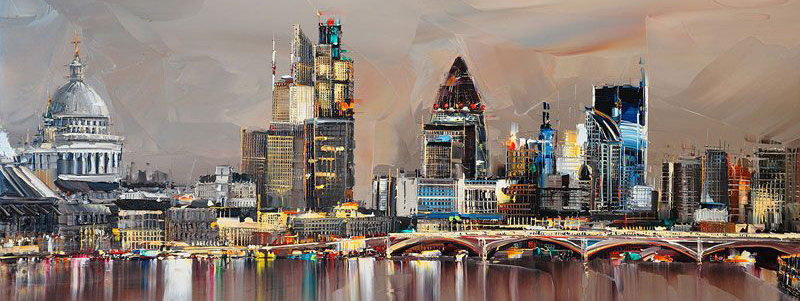Whitehall - Strand
The City of Westminster is a very vast area of the capital, which comprises (beyond the original settlement where today we find many British institutions) the majority of the West End, with Piccadilly Circus, Trafalgar Square and Hyde Park.
Today it is difficult to imagine that the area where there is now the Abbey was once a swampland beaten by wind. he reason for which this place was chosen for the construction of the Abbey was really because of its isolation, far from the temptations of the city, so it was ideal for a monastery. Moreover, it was well supplied with water. Today, Westminster reaches from Hampstead to the Thames and from Kensington to the City. It occupies a great part of the center of London and a major part of the West End. It is divided into different locations, including the well known areas around Parliament, Buckingham Palace and the area around 10 Downing Street. It also comprises other areas around Oxford Street, Regent Street, Piccadilly, Bond Street and Soho. Westminster, in its original significance, meant “western church”. It’s true that it is a touristic and well-known place, but notwithstanding this, there are many details and elements that usually escape observation and it’s a good idea to dwell a bit on them.
WESTMINSTER ABBEY
20 DEAN'S YARD
UNDERGROUND: WESTMINSTER
Since Christmas Day in 1066, when William the Conqueror celebrated his coronation, Westminster Abbey has been the place of coronation of all the sovereigns, as well as that of their burial. Given its importance, there are many monuments, the great majority of which are marble, which demonstrate almost an anthology of civil history, literature, art and British science. In addition to the Kings, in the Northern transept are buried the statesmen Peel, Palmerston, Disraeli and Gladstone, the scientists, Darwin, Newton, Herschel and others. In the Northern choir aisle, where we find the organ, are the tombs of Handel, Purcell, Blow and others. In the Southern transept are the writers and poets. There is also the statue of the actor Garrick.
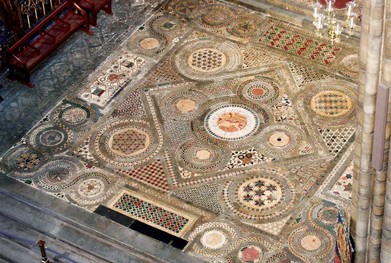 Italian artists in Westminster - There are so many Italian works of art in the Abbey that one could dedicate an entire tour to them.
Italian artists in Westminster - There are so many Italian works of art in the Abbey that one could dedicate an entire tour to them.The principal altar, in front of which are held the Coronation ceremonies, was designed in 1867 by Gilbert Scott. It stands out against an altar piece with a mosaic of the The Last Supper, designed by J. R. Clayton and created by Salviati. The image of the Last Supper is next to the statues of Saint Peter and Saint Paul, Moses and David. The mosaic on the floor is covered by a carpet to protect it, and was created in 1268 by Cosmati. It was placed by the artisan Odericus, who the Abbot Ware had invited from Rome. It is created in marble with stone inserts of wavy and zigzag glass, in square and circular forms (this floor is reproduced in the painting by Holbein with the title “The Ambassadors” which is in the National Gallery). On the North side of the presbytery there are magnificent tombs surmounted by elaborate canopies, at the bases of which are some little statues of men and women crying, similar to the hired mourners.
In the back of the main altar there is the marble tomb of Edward the Confessor. The mosaics were created by Peter, civis romanus, a Roman citizen who was perhaps the son of Odericus.
THE POETS' CORNER
SOUTH TRANSEPT
WESTMINSTER ABBEY
UNDERGROUND: WESTMINSTER
Many are the writers and poets buried here, starting with Chaucer, who has been here for six hundred years. In 1599, when Edmund Spenser was buried, his friends and fellow writers gathered in this place and filled his tomb with their elegies and the pens that they had used to write them. Also here are Dryden, Milton, Coleridge, Wordsworth, Byron, Tennyson, Browning, Dickens, Kipling, T.S. Eliot, Dylan Thomas, James, and Auden. In the Poets' Corner they have been commemorated with busts, amongst which that of William Blake (honoured in death and considered crazy during his lifetime) is especially noteworthy and was sculpted by Jacob Epstein in 1957.
Also Thomas Hardy was buried here, except for his heart, placed in a biscuit tin and brought to Stinsford in Dorset, in order to be arranged amongst his ancestors. Also buried here are Thomas Grey and James Macpherson, the creator of the Poems of Ossian. Also present is Robert Browning, delivered here from Venice, where he passed away, and the greatest of all, George Gordon Byron.
THE WAX STATUES OF THE KINGS AND QUEENS
20, DEAN'S YARD
UNDERGROUND: WESTMINSTER
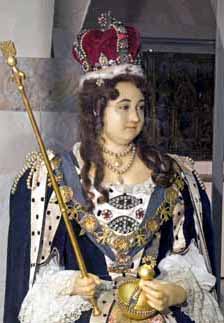 Beneath the vaulted crypt of St Peter's, which dates back to the Eleventh Century, there is a fascinating collection of funeral effigies of royal characters. The crypt is the most ancient part of the church, dates back to the Eleventh Century, and is situated on the East side of the cloister. The craftsmanship of the statues is excellent, and great attention has been given to detail. Some of them, the oldest, are made in wood, others are in wax, and are dressed with clothing that was once part of the royal wardrobe. The facial features were made to be as similar as possible to real life. The effigy of Edward III is the most ancient to exist in Europe, and even the eyebrows, made of tufts of dog's fur, are well conserved. It was used at his funeral in 1377. The statue of Henry VII has very similar facial features as they are based on his death mask. There are also wax statues of Elizabeth I, Charles II, who succeeded Cromwell, William III, and Queen Anne, the last member of the royal family to be buried here. Next to the queen stands her little parrot, one of the first animals to be stuffed with straw and to have been preserved until now. Also present are the statues of Nelson and William Pitt. Nearby are a series of objects which were in some way connected to these characters of the past, such as the saddle, helmet, and sword belonging to Henry V, some medieval panels of tinted glass, the coronation throne of Mary II, and some copies of ceremonial gifts. There is a Roman sarcophagus from the Fourth Century discovered in the location itself, and a retablo from the Thirteenth Century.
Beneath the vaulted crypt of St Peter's, which dates back to the Eleventh Century, there is a fascinating collection of funeral effigies of royal characters. The crypt is the most ancient part of the church, dates back to the Eleventh Century, and is situated on the East side of the cloister. The craftsmanship of the statues is excellent, and great attention has been given to detail. Some of them, the oldest, are made in wood, others are in wax, and are dressed with clothing that was once part of the royal wardrobe. The facial features were made to be as similar as possible to real life. The effigy of Edward III is the most ancient to exist in Europe, and even the eyebrows, made of tufts of dog's fur, are well conserved. It was used at his funeral in 1377. The statue of Henry VII has very similar facial features as they are based on his death mask. There are also wax statues of Elizabeth I, Charles II, who succeeded Cromwell, William III, and Queen Anne, the last member of the royal family to be buried here. Next to the queen stands her little parrot, one of the first animals to be stuffed with straw and to have been preserved until now. Also present are the statues of Nelson and William Pitt. Nearby are a series of objects which were in some way connected to these characters of the past, such as the saddle, helmet, and sword belonging to Henry V, some medieval panels of tinted glass, the coronation throne of Mary II, and some copies of ceremonial gifts. There is a Roman sarcophagus from the Fourth Century discovered in the location itself, and a retablo from the Thirteenth Century.THE SCHOOL FOR NOVICES
LITTLE DEAN'S YARD
UNDERGROUND: WESTMINSTER
Behind the abbey, surrounding Dean's Yard, stands the medieval building of the Royal College of St Peter at Westminster, better known as Westminster School. It was once the school for novices; now it is one of the most famous independent institutes in the United Kingdom, and Queen Elizabeth is considered the founder of the present-day school, which is located in the centre of London near Westminster Abbey and whose history dates back to before the Twelfth Century. Around eight hundred pupils attend the school, both male and female. Some of its most famous students have been the poet and playwright Ben Jonson, the philosopher John Locke, the architect Christopher Wren, and in more recent times, the actors John Gielgud and Peter Ustinov. The School Hall, which is not visible, was part of the monastery dormitory.
THE DUKE'S HOUSE
LITTLE DEAN'S YARD
UNDERGROUND: WESTMINSTER
In 1882, Ashburnham House was purchased by Westminster School, and since then has been a part of the school premises. It was designed by Inigo Jones, for the family which was to later become that of the duke of Ashburnham. Well Hall incorporates the remains of the medieval Priory House, with its wooden panelling and plaster. During the Second World War, the library hall was used by the Royal Air Force as a communication operating HQ. There is also a marvellous staircase. The garden hosts what remains of Edward the Confessor's abbey.
In 1969, some of the scenes from the film The Magic Christian were shot here, starring Peter Sellers, Ringo Starr, and an army of other actors and famous celebrities. The beginning of the story is almost Dickensian, with a millionaire adopting an orphan whom he has met in the park, and it contains satire which often harshly addresses capitalism, greed, and human vanity
THE NINE-HUNDRED-YEAR-OLD GARDEN
LITTLE DEAN'S YARD
UNDERGROUND: WESTMINSTER
College Garden has existed for a good nine hundred years, and is the most ancient garden of England, cultivated without interruption. At first, it consisted of therapeutic plants. The monk in charge of tending to sick and elderly companions would use the plants to heal them and would also manage a dispensary for the local population. He would decide which medicinal herbs to grow and amongst these, fennel and hyssop were always a must. There was also a grove producing apples, pears, prunes, and grapes, as well as an orchard which yielded leeks and broad beans. In the field, events are still held today in order to collect funds for cancer research. In the Sixteenth Century there were two ponds with water-lilies, cultivated because of their cardiotonic properties. A remnant of that age is an area of the perimeter wall at the back of the garden. The five sycamores, instead, date back to 1850.
THE JERUSALEM CHAMBER
WESTMINSTER ABBEY
UNDERGROUND: WESTMINSTER
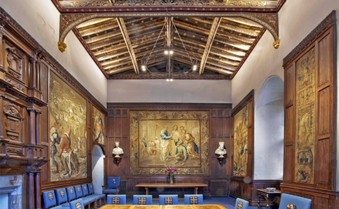 The Jerusalem Chamber was built at the end of the Fourteenth Century. Henry IV was brought to this room after having suddenly fallen ill whilst praying in front of the sacrarium of St Edward in 1413, the day before his departure for the Holy Land. When he regained consciousness, he asked where he was. Once he heard the name of the room being spoken to him, he realised that he was to die there, seeing as a prophecy had told him that he would spend his last days in Jerusalem. Some of the glass panes are from the Fourteenth Century and parts of the tapestry were carried out in Brussels halfway through the Sixteenth Century.
The Jerusalem Chamber was built at the end of the Fourteenth Century. Henry IV was brought to this room after having suddenly fallen ill whilst praying in front of the sacrarium of St Edward in 1413, the day before his departure for the Holy Land. When he regained consciousness, he asked where he was. Once he heard the name of the room being spoken to him, he realised that he was to die there, seeing as a prophecy had told him that he would spend his last days in Jerusalem. Some of the glass panes are from the Fourteenth Century and parts of the tapestry were carried out in Brussels halfway through the Sixteenth Century.THE PALACE OF THE PARLIAMENT
PARLIAMENT SQUARE
UNDERGROUND: WESTMINSTER
UNDERGROUND: WESTMINSTER
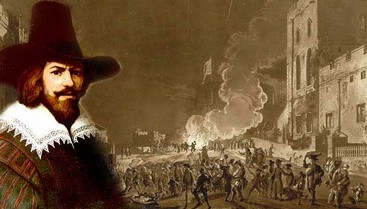 The building looks out onto Parliament Square, which was built by Barry in a style which was meant to reach the level of nobility of the building itself. There are many statues from the Nineteenth Century representing political figures, amongst which Lord Palmerston and Disraeli, carried out in 1883 by Mario Raggi. In the Twentieth Century, amongst others, also Churchill's was added, carried out by Robert Jones. To one side, stands that of Abraham Lincoln, a copy of the original in Chicago.
The building looks out onto Parliament Square, which was built by Barry in a style which was meant to reach the level of nobility of the building itself. There are many statues from the Nineteenth Century representing political figures, amongst which Lord Palmerston and Disraeli, carried out in 1883 by Mario Raggi. In the Twentieth Century, amongst others, also Churchill's was added, carried out by Robert Jones. To one side, stands that of Abraham Lincoln, a copy of the original in Chicago.Throughout its history, the palace of the Houses of Parliament has passed through a series of events which endangered its very existence. One of these episodes was connected to a group of British Catholics who felt oppressed by King James I, who had turned to the Protestant religion. They planned an attack which was meant to unfold on November 5th, 1605.
However, someone had betrayed them, and the royal guard captured Guy Fawkes in the palace cellars, as he was planting the explosives. He was subjected to torture in the Tower, and gave up the names of his accomplices, who were promptly captured and executed, their heads impaled and put on show in Parliament Square. Since that day, the Palace cellars have always undergone a thorough search before Parliament gathers. However the destruction of the palace came from a different source: a fire, which started during the night of October 16th, 1834. Charles Barry had won the bid for its reconstruction. The text of the competitive bid specified that the building was to be built in the Gothic or Elizabethan style. Barry had a distinct taste for the Italian style which he had already applied to the Travellers Club in Pall Mall. According to his project, the facade was to have an Early Tudor style. The building, completed in 1860, was the result of a collaboration between Barry and Pugin, helped by an exceptional workforce of artists, artisans, and sculptors.
Westminster Hall, in Storey's Gate, is the most ancient part of the palace. It was the great hall of the Kings of England, commissioned by William Rufus, the son of the Conqueror, in 1099.
This is where the courts of justice would once assemble; this is where judgment and sentences were inflicted upon the likes of Thomas More, in 1535, Guy Fawkes, in 1606, and King Charles I, in 1649. The fire of 1834 did not damage it, and today it is used as a chapelle ardente for the members of the royal family.
OLIVER CROMWELL
CROMWELL GREEN
UNDERGROUND: WESTMINSTER
UNDERGROUND: WESTMINSTER
In front of Westminster Hall, there is a bronze statue of Oliver Cromwell, carried out by Hamo Thornycroft, and discovered in 1899. It is rather bizarrely ironic that this puritan should have a statue in the very place where Charles I was tried, as during the eleven years of his government he proceeded to shut down theatres, ban gambling, tennis, and public monuments which he believed could lead to idolatry. Cromwell is immortalized looking towards his old enemy, King Charles, whose miniature bust has been placed in a niche just above the portal of the church of St Margaret.
Cromwell died seven years after his victory in the Battle of Worcester in 1651, which forced Charles I to leave the country. He was buried in the chapel of Henry VII, yet in 1661, with the onset of the Restoration, Charles II had him removed. His decomposing corpse was left for a night in Red Lion Square, then taken to Tyburn, impaled on a fork for a few days, and finally exhibited on the rooftop of Westminster Hall, until a gust of wind toppled it off. It was then recovered and taken to Sidney Sussex College, where he had studied and where his corpse is still kept now.
RICHARD THE LIONHEART
OLD PALACE YARD
UNDERGROUND: WESTMINSTER
UNDERGROUND: WESTMINSTER
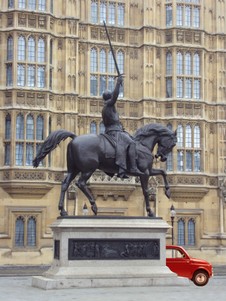 In Old Palace Yard stands the equestrian bronze statue of Richard I, nicknamed Richard the Lionheart, born in 1157. Richard was King of England, although he barely knew English. He was also the Duke of Normandy and Count of Nantes and Anjou. The nickname derives from his reputation as a warrior. At the age of sixteen he already had his own army, in Poitou he defeated the rebels who were fighting against his father Henry II. He took part in the Third Crusade, gaining victories against the Saladin.
In Old Palace Yard stands the equestrian bronze statue of Richard I, nicknamed Richard the Lionheart, born in 1157. Richard was King of England, although he barely knew English. He was also the Duke of Normandy and Count of Nantes and Anjou. The nickname derives from his reputation as a warrior. At the age of sixteen he already had his own army, in Poitou he defeated the rebels who were fighting against his father Henry II. He took part in the Third Crusade, gaining victories against the Saladin. Amongst his military campaigns was the attack unleashed on the uprising in the city of Messina, on October 4th, 1190, followed by it being sacked and burnt down. He died between his mother's arms, due to the gangrene which had developed from an arrow wound. His brain is buried in the abbey of Charroux in Poitou, his heart in Rouen, Normandy, and the rest of the body in Fontevraud Abbey, in Anjou.
His statue is the work of the sculptor Carlo Marochetti, who left Piedmont at the time of the insurrections in 1848. In London, the baron Marochetti had become an academic and a friend of the prince consort. He carried out the statue in 1860. During the Victorian epoch, King Richard was much admired for his participation in the Crusades, and was considered a man of God. The statue has a heroic pose to it, with the king brandishing his sword fiercely.
His statue is the work of the sculptor Carlo Marochetti, who left Piedmont at the time of the insurrections in 1848. In London, the baron Marochetti had become an academic and a friend of the prince consort. He carried out the statue in 1860. During the Victorian epoch, King Richard was much admired for his participation in the Crusades, and was considered a man of God. The statue has a heroic pose to it, with the king brandishing his sword fiercely.
JEWEL TOWER
OLD PALACE YARD
UNDERGROUND: WESTMINSTER
This small three-storey tower which now stands isolated is one of the few fragments to be left of the old palace of Westminster. It was built in 1366, and at first, was a prison belonging to the abbey. Subsequently, it was acquired by the royals as a place to keep their jewellery and collection of clothes. The jewellery is still kept in these rooms with panelled ceilings, which until 1540 were interconnected by a spiral stone staircase. On the ground floor there are still some stone roundels and capitals which were part of the original palace of Westminster. They bear sculpted figures of knights, eagles, lions, and birds. In a water painting one can admire the tower as it was before the Reform, with monks busy in the wall-encircled gardens. In the Eighteenth Century, the registers of the House of Lords were kept in the tower.
For visitors there is a small exhibition on the history of the palace and the tower. The moat, still filled with water, served as a first line of defence. There were once fish swimming in it, now there are water-lilies. The water comes from a small stream, which follows the same path as it did a thousand years ago, before it disappeared underground and became an affluent of the Thames.
KNIFE EDGE
ABINGDON STREET
UNDERGROUND: WESTMINSTER
In front of the palace of the Parliament, these two bronze statues which go by the name Knife Edge Two Piece are situated in front of Victoria Tower and are the work of Henry Moore. They bear the undulated shape which is so typical of this sculptor, who is famous for his abstract and monumental works, often depicting human figures which hint at the shapes of the female body. In the Fifties, he sculpted many family groups. He introduced modernism into Great Britain, along with the concept that art should return to its pre-cultural and pre-rational origins, influenced by the Mayan and Toltec figures of the Louvre.
TAXI LIGHTS
PARLIAMENT SQUARE
UNDERGROUND: WESTMINSTER
At the corner of Parliament Square with Bridge Street, at the top of a stone pillar, stands a small streetlamp. The light bulb inside starts to flicker as a sign that somebody within Parliament is in need of a taxi, and drivers passing by can stop to pick them up. A few minutes before leaving, the MPs will notify the guard at the gates to switch the flickering light on.
On the opposite side of the Thames are the Black Rod's steps, which get their name from the Black Rod's Garden, where they start. The pavilion is a simple porch, which could have been used as shelter by passengers of ferries waiting under the rain. It no longer holds much use and is purely decorative.
CHURCH OF ST MARGARET
20, DEAN'S YARD
UNDERGROUND: WESTMINSTER
The current church, in the late Gothic style, dates back to 1500 and fits in harmonically with the abbey. The original one, however, was founded at the start of the Twelfth Century by Benedictine Monks. Later on, the choir and tower were added. The church is dedicated to Margaret of Antioch, the saint who was forced by her father to act as a pig guardian in order to punish her conversion to Christianity. The saint is often painted with a dragon under her feet, defeated with the sign of a cross placed above it.
During the past century, members of Parliament used to come here for the divine service in the days connected to historical commemorations, such as that in memory of the execution of Charles I, the Restoration, and Guy Fawkes' conspiracy. Still today, it is the church for MPs. Its treasure is the eastern glass pane, fabricated in the Flanders for the wedding of prince Arthur with Catherine of Aragon. It bears the representation of Christ's Crucifixion, and to the sides are Saint George and Saint Catherine of Alexandria. The various characters stand out against the blue background. Under the glass pane there is a carved reredos, dating back to 1753, which depicts the supper at Emmaus. Under the greater altar, lies buried the headless body of the soldier and explorer Walter Raleigh, executed in Old Palace Yard. Amongst the funeral monuments, there is an allegory dedicated to Peter Parker, sculpted by C. Prosperi in 1814. The southern panes are the work of John Piper and were added in 1966.
MILLBANK
UNDERGROUND: WESTMINSTER
The area which runs along the Thames, east of Pimlico and south of Westminster, owes its name to a windmill which belonged to a nearby abbey. Today the area hosts numerous buildings from the Thirties, the period during which the area was rebuilt after the overflowing of the Thames. A section of twenty-five metres of the docklands wall collapsed and the river water burst the banks. There is also a large street going by such name along the north bank of the Thames, which was built halfway through the Nineteenth Century as part of the Embankment and which passes above a large cesspool.
South of St Margaret's church, there is a palace which was once the headquarters of the ICI, the Imperial Chemical Industries. In 2008 the chemical industry was acquired by Akzo Nobel, a Dutch multinational specialized in the production of paints and chemical products. The building was designed in 1928 by F. Baines. The metal doors of the main entrance are decorated with panels with bas-reliefs which portray man and his relationship with science and industry. Above the door there is nineteenth-century bas-relief of Britannia, symbolized by a bearded and crowned head. These are the work of William Fagan and are considered beautiful to the point of rivalling those by Ghiberti in the Florence Baptistery.
TATE BRITAIN AND TATE MODERN
MILLBANK
UNDERGROUND: WESTMINSTER
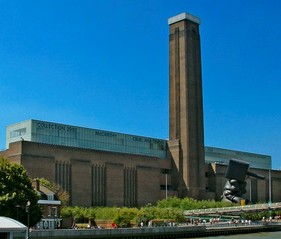 The gallery hosts five hundred years' worth of British art, including Blake, Turner, Gainsborough, Constable, and Bacon, and the entrance is free. There are also numerous exhibitions throughout the year. On the first Friday of the month, the Tate Britain opens its doors until 10 p.m. for the Late at Tate, at half-price. The Tate Modern, instead, offers Saturday Live, a program of events with music, films, performances, discussions, and art shows until late. One should note that the two galleries are connected by the Tate to Tate, a boat service which leaves from the Marks and Barfield Millbank Pier, near the Tate Britain, and arrives at the Bankside Pier, where the Tate Modern is situated. The boats leave every forty minutes, during the opening hours of the gallery. The ticket can be bought onboard and there is one for a longer route.
The gallery hosts five hundred years' worth of British art, including Blake, Turner, Gainsborough, Constable, and Bacon, and the entrance is free. There are also numerous exhibitions throughout the year. On the first Friday of the month, the Tate Britain opens its doors until 10 p.m. for the Late at Tate, at half-price. The Tate Modern, instead, offers Saturday Live, a program of events with music, films, performances, discussions, and art shows until late. One should note that the two galleries are connected by the Tate to Tate, a boat service which leaves from the Marks and Barfield Millbank Pier, near the Tate Britain, and arrives at the Bankside Pier, where the Tate Modern is situated. The boats leave every forty minutes, during the opening hours of the gallery. The ticket can be bought onboard and there is one for a longer route. Other galleries, such as Whitechapel Gallery, are open for the First Thursdays. There are also evocative candlelit evenings, at the Dennis Severs' House and John Soane's Museum.
WESTMINSTER WALK
UNDERGROUND: WESTMINSTER
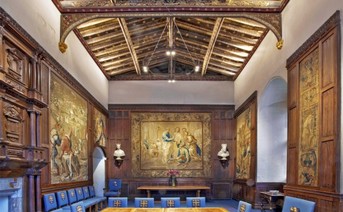 Surrounding Westminster Abbey is a network of peaceful back roads, which have evocative historical names: Abbey Orchard stands where there was once an old medieval orchard belonging to the monks of St Peter's. Old Pyre Street is dedicated to a depute of King Charles I. Barton Street is named so in honour of the actor who built it. Another is Lord North Street, at the end of which the baroque church of St John's in Smith Square is situated. All of these roads are coasted by delightful Georgian houses, which were once built for artisans and later became much sought-after due to their position. Some of the original street signposts have remained, engraved on stone slabs, which bear the date 1722. On the facade of a few houses there is a faded arrow and the letter 'S' at the level of the road. The arrow indicates the bomb shelters in the underground which were active during the Second World War. The walk through these marvellously conserved residential streets is made all the more exciting by the fact that they are extremely close to the confusion of the adjacent touristic area.
Surrounding Westminster Abbey is a network of peaceful back roads, which have evocative historical names: Abbey Orchard stands where there was once an old medieval orchard belonging to the monks of St Peter's. Old Pyre Street is dedicated to a depute of King Charles I. Barton Street is named so in honour of the actor who built it. Another is Lord North Street, at the end of which the baroque church of St John's in Smith Square is situated. All of these roads are coasted by delightful Georgian houses, which were once built for artisans and later became much sought-after due to their position. Some of the original street signposts have remained, engraved on stone slabs, which bear the date 1722. On the facade of a few houses there is a faded arrow and the letter 'S' at the level of the road. The arrow indicates the bomb shelters in the underground which were active during the Second World War. The walk through these marvellously conserved residential streets is made all the more exciting by the fact that they are extremely close to the confusion of the adjacent touristic area.For those who on the contrary do not wish to walk but are interested in the modern architecture of the underground stations, one can board the trains of the Jubilee Line at Westminster and get off at any of the stations in the Greenwich-bound direction. These are the work of famous contemporary British architects: Hopkins, MacCormac, Jiricna, Foster... Canary Wharf Station, designed by Norman Foster, is three hundred and thirteen metres long, has an ellipsoidal shape, is deeply penetrated by rays of light, and is served by futuristic lifts.
SMITH SQUARE
UNDERGROUND: ST JAMES'S PARK
Smith Square is a peaceful square in the heart of Westminster. The surrounding streets are flanked by small houses from the early Eighteenth Century, almost all inhabited by the members of Parliament, due to their proximity to it. The square bears the family name Smith because of the fact that it owned the terrain where the square was built. It was one of the family members who, in the Eighteenth Century, started its construction. At first a family house was erected, at number 1, which the descendents continued to inhabit. The houses ranging from numbers 1 to 9 are the original ones.
At number 17, stands Nobel House, built in 1928 for the Imperial Chemical Industries, and which now hosts the Department for Environment, Food, and Rural Affairs. Since 1904, number 5 has been the home of the pioneer of investigative journalism, William Thomas Stead, who died onboard the Titanic in 1912. For almost fifty years, also the headquarters of the Conservative Party was situated in what is now known as the Europe House, headquarters of the European Parliament in London.
CHURCH OF ST JOHN
SMITH SQUARE
UNDERGROUND: ST JAMES'S PARK
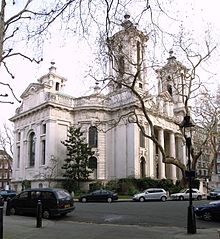 The church of St John, at the centre of Smith Square, was defined by Dickens in Our Mutual Friend, as "a very hideous church". In actual fact, what really subtracts the harmony from the church as a whole are the four tall towers; aside from this, the church resembles a small neo-classic temple. At the end of the Second World War, the building was reduced to a pile of rubble, but later rebuilt.
The church of St John, at the centre of Smith Square, was defined by Dickens in Our Mutual Friend, as "a very hideous church". In actual fact, what really subtracts the harmony from the church as a whole are the four tall towers; aside from this, the church resembles a small neo-classic temple. At the end of the Second World War, the building was reduced to a pile of rubble, but later rebuilt. Thomas Archer designed it in 1728 in the baroque style following a Greek-cross plan. There is a tower in each corner and a porch with enormous Tuscan pillars at the sides of the entrances. In 1969 the church was restored by Marshall Sisson and destined for different uses. For many years it was the gathering point for political parties and offices, and today, thanks to its exceptional acoustics, it is used for concerts of classical music. Here, great executors of international fame succeeded each other allowing one to witness, as in the words of Hugh Casson, experiences impossible to find elsewhere, and hear beautiful music within its spaces.
It is nicknamed "Queen Anne's Footstool" because, according to legend, when the architect Archer had asked her which features the building should have, she had aimed a kick at the footstool and told him: "like so!" Because of this, the four towers were added. This is how legend would have it; in reality, the towers were built because the building needed to be stabilized.
MUSEUM OF THE LONDON SCOTTISH REGIMENT
95, HORSEFERRY ROAD
UNDERGROUND: ST JAMES'S PARK
In the armoury of the regiment's headquarters, a small but complete collection has been gathered, which tells the story of the London Scottish Regiment. On the two balconies which run along the walls of the room, is a collection of medallions, uniforms, personal equipment, various types of weapons of different sizes and the greatcoat of Lord Elcho. The walls hold paintings and old photographs.
The Scottish regiment, made up of a battalion of voluntary soldiers, was formed in 1859. There are also medals and uniforms belonging to Colonel Ogilby, the founder of the military museums. The regiment also counted Alexander Fleming amid its ranks, as well as Eric Newby. It can be visited only via booking.
THE LIONESS AND LION OF WESTMINSTER BRIDGE
UNDERGROUND: WESTMINSTER
Boudica was the queen of the Iceni and guided the rebellion of her people, dwellers of the area of Norfolk, against the Romans. After having razed Colchester and St Albans, Boudica targeted London. The Roman Governor Svetonio Paolino was in Wales suppressing a rebellion. When he returned to find that he had lost around seven thousand legionaries, he prepared for revenge. Boudica then decided to poison herself so as not to fall prisoner to the Romans. Her soldiers hurriedly left London, taking her body with them, and buried it in the open countryside, north of London. Today, King's Cross Railway Station is situated in this area.
Although it is little more than legend, it is said that she is buried under platform 10, where the trains leave for Norfolk. The Londoners say that their city is the only one to have erected a monument to the person who razed it to the ground.
On the other side of the bridge, towards Lambeth, stands a great statue of a lion, built in Coade Stone. In spite of its name, the material is not actually stone, but a substitute for ceramic. However, it is so realistic that even Robert Adam used it for the details of his facade.
TIDE KIOSK
WESTMINSTER BRIDGE
UNDERGROUND: WESTMINSTER
There are indicators of level which are checked each day and were also used to forecast very choppy weather.
Here there is a buoy connected via cord to a nib, which over the 24 hours records variations in the tide on a sheet of paper. In the Thames, the sea currents have a variable force and direction. The numbers above the arrows show the maximum speed of the current and the circles indicate the times for the tide reflux. In fact the sea current inverts the sense of that of the river, even upstream of London, increasing its level.
The gentle curve of Whitehall connects Trafalgar Square with the abbey of Westminster and the palace of Parliament. This important street is flanked on both sides by a series of government and administration offices, which represent the epitome of what was the "official" architecture of the capital from the Sixteenth to the Twentieth Century. One of the most beautiful and imposing buildings is the ex-India Office, today the headquarters of the Foreign Affairs Ministry, the work of George Gilbert Scott, which is inspired by the Italian style, with the couples of Corinthian pillars, the statues in niches and the balconies. It was Palmerston who desired it to be built so, against the will of the architect.
Also the splendid facade of the palace of the Ministry of the Treasury is of Italian inspiration. The building stands in the place of Cockpit Passage, a mysterious tunnel that leads all the way to the Horse Guards Parade. Near to it is Tennis Court, its building still existing today, with a wall where there are remains of a brick oven. Also in the lateral streets there are noteworthy buildings, such as for example in Craig's Court, where Harrington House is located, built in 1702, with a brick facade and stone toothing.
THE PALACE OF WHITEHALL
WHITEHALL
UNDERGROUND: CHARING CROSS
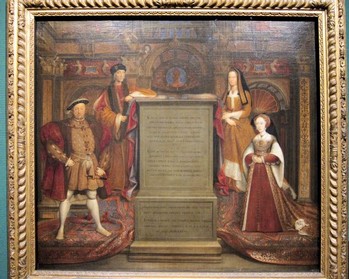 The construction of York Place - that is what it was called at the time - began in 1514, when cardinal Wolsey became primate. It was supposed to become his residence. Unfortunately, in 1529 he had lost the king's favour and, as a consequence, also the property of the building. Henry VIII, after having confiscated the building, went to live there, leaving the medieval buildings to the Parliament and the public employees. The palace was re-baptized Whitehall, but was completely destroyed by flames in 1698. The fire was started by a laundress, who had put her clothes in front of the fire to dry. Amongst the objects which survived, is a preparatory picture by Hans Holbein, which portrays Henry VIII in real-life scale and which is now found at the National Portrait Gallery. It was a study for the fresco which in 1537 decorated the wall of the Privy Chamber, his private chamber. The painting was lost, but we know it thanks to an accurate copy painted by Remigius van Leemput, which is now in Hampton Court. The fresco represented Henry VIII with Queen Jane Seymour and Henry VII with Elizabeth of York, who had been at war for thirty years, from 1455 to 1485.
The construction of York Place - that is what it was called at the time - began in 1514, when cardinal Wolsey became primate. It was supposed to become his residence. Unfortunately, in 1529 he had lost the king's favour and, as a consequence, also the property of the building. Henry VIII, after having confiscated the building, went to live there, leaving the medieval buildings to the Parliament and the public employees. The palace was re-baptized Whitehall, but was completely destroyed by flames in 1698. The fire was started by a laundress, who had put her clothes in front of the fire to dry. Amongst the objects which survived, is a preparatory picture by Hans Holbein, which portrays Henry VIII in real-life scale and which is now found at the National Portrait Gallery. It was a study for the fresco which in 1537 decorated the wall of the Privy Chamber, his private chamber. The painting was lost, but we know it thanks to an accurate copy painted by Remigius van Leemput, which is now in Hampton Court. The fresco represented Henry VIII with Queen Jane Seymour and Henry VII with Elizabeth of York, who had been at war for thirty years, from 1455 to 1485. In 1960 a stretch of the Tudor wall was discovered and is now incorporated in the southern side of the palace of the Ministry of the Treasury.
Also the docking stairs designed by Christopher Wren for Mary II have been preserved, and are no longer found on the side of the river but in front of the building of the Ministry of Defence. Observing its distance from the bank, one can realise just how much the Embankment reduced the width of the Thames.
Henry VIII died in this palace, and Queen Mary received the declaration of obedience of his subjects after the rebellion of Wyatts. Elizabeth I held her court here.
THE CELLAR OF HENRY VIII
WHITEHALL, MINISTRY OF DEFENCE
UNDERGROUND: WESTMINSTER
The English, not being great producers of wine, never reached the perfection of Italians or French in constructing this type of space, with the differentiation between the cellar for ageing, which has a constant ideal temperature, and the "bottle cellar", a section of the cellar with shelves made especially for bottles. Certainly, this type of subtlety was far from the minds of those who dug out these cells, which are now located in the underground section of the Ministry of Defence. The vaulted rooms were built in 1520 by Cardinal Wolsey, archbishop of York and lord chancellor of England for a cellar to be made. Today it is tied to the name of Henry VIII, because he had taken possession of Whitehall Palace. The cellar survived the fire in the palace, which took place in 1698. The palace had a thousand rooms, but being built in wood, it was completely destroyed.
The cellar was then left relatively undisturbed until 1946, when it was decided that a new Ministry be set up and it was realised that the room was a hindrance to this end. Therefore, instead of destroying it, it was decided that it be moved. It was enclosed between cement walls, with a platform of sturdy beams slipped underneath it, and it was lifted with a winch, one centimetre at a time.
It was then shifted in this harness three metres north of its original position and lowered six metres into the ground into the terrain which had been dug out to this purpose, and laid onto a series of steel cylinders. And so it is that today the flooring where the bottles and barrels of Henry VIII is unchanged and the same as it once was; the bricks are the same ones as four centuries ago, as are the arches which rest on octagonal pillars at the centre of the room. The only addition are the tubes for the heating, which run along the walls. Above the cellar, stands the looming Ministry building. Unfortunately today, for security reasons, it is quite difficult to visit it, however there are guided visits for groups; children are excluded.
RUBENS AT THE BANQUETING HOUSE
WHITEHALL
UNDERGROUND: WESTMINSTER
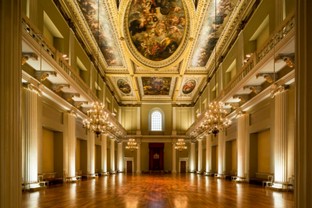 Many people are not aware of the fresco on the ceiling of the hall that was once part of the pre-existing palace of Whitehall, completed in 1622 by Inigo Jones. This architect, who had travelled and studied architecture in Italy, was the first to bring the Italian Renaissance to England. He began as a theatre designer, preparing the backdrop for the court masques in collaboration with Ben Jonson, an allegorical representation which was mostly musical and choreographic, rehearsed by patricians at court and in their castles during the Sixteenth and Seventeenth Centuries.
Many people are not aware of the fresco on the ceiling of the hall that was once part of the pre-existing palace of Whitehall, completed in 1622 by Inigo Jones. This architect, who had travelled and studied architecture in Italy, was the first to bring the Italian Renaissance to England. He began as a theatre designer, preparing the backdrop for the court masques in collaboration with Ben Jonson, an allegorical representation which was mostly musical and choreographic, rehearsed by patricians at court and in their castles during the Sixteenth and Seventeenth Centuries. The Banqueting House, in 1619, along with the cellar which we have spoken about in the previous chapter, is a part of the Whitehall palace which has been saved. It represents the greatest example of this architectural style, and the hall is a milestone in the history of English architecture. The windows of the first floor, which have alternating rounded and triangular gables, are separated by Ionic pillars. Those of the second floor are squared-off at the top, and separated by Corinthian pillars, which uphold a frieze of garlands and sculpted heads. Along the upper edge runs a balustrade.
The hall of the fresco is the same height of the building. A gallery upheld by Ionic pillars runs all around the room and the ceiling is divided into nine compartments.
A painter and diplomat - Pieter Paul Rubens, who was a diplomat as well as a painter, was sent here in 1629 to try and improve relations between England and Spain. During his stay, Charles I asked him to carry out a series of paintings in order to fill the vast compartments of the ceiling of this hall. The theme was to be that of the union between England and Scotland, at the time under the benevolent sovereignty of his father James I, who died in 1625. The work was completed in 1634 and shows the Apotheosis of James I, namely the solemn ceremony through which dead heroes were deified, with the scene in which the monarch is taken into the sky by Justice.
The cherubs, symbols of prosperity, crowd the nearby compartments, whereas at the southern extremities the benefits granted under the reign of James I are represented in a symbolic fashion. Amongst them are Peace and Wisdom, who chase off the enemies of the king. In the two nearby ovals, we can see Abundance undermining Greed and Reason curbing Discord. At the northern extremity the king is portrayed, smiling, as he hands his sceptre to a naked child, who represents the union between the two reigns which had just been formed. Britannia holds two crowns above his head. In the side ovals, one can see Hercules, symbol of heroic virtue, as he strikes out with his club against Envy, and Minerva piercing Ignorance.
Part of the work on the fresco was carried out by Rubens' assistants, however the painter stated that he was the author of the main figures and the result is magnificent. Not quite so magnificent was the destiny met by Charles I, the commissioner of this masterpiece. After having spent seven years far away in the attempt of subjugating the rebels, he passed through this room which celebrates his father one last time to make his way to the guillotine.
The nearby Cockpit Passage and the wall with a tympanum above it, which once bordered the tennis pitch of Henry VIII, are two other parts which survived the fire of Whitehall Palace.
SCOTLAND YARD
4 WHITEHALL PLACE
UNDERGROUND: WESTMINSTER
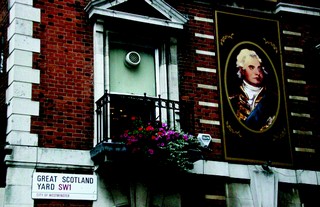 Until the Eighteenth Century, this was the London residence of the King of Scotland and of the diplomats whenever they would come to London on a mission. After the two reigns united, the building was turned into a series of offices, until in 1829, the Police force established its headquarters here. The rear entrance lead onto Scotland Yard, whose rather picturesque name attracted the interest of newspapers and the public. Because of this, it was decided that it be officially named so, which stuck even when the headquarters were moved to a different location, and used to indicate the police department.
Until the Eighteenth Century, this was the London residence of the King of Scotland and of the diplomats whenever they would come to London on a mission. After the two reigns united, the building was turned into a series of offices, until in 1829, the Police force established its headquarters here. The rear entrance lead onto Scotland Yard, whose rather picturesque name attracted the interest of newspapers and the public. Because of this, it was decided that it be officially named so, which stuck even when the headquarters were moved to a different location, and used to indicate the police department. Today the base of the New Scotland Yard, namely the metropolitan police, is in Westminster. The old headquarters still holds the database of committed crimes via a system called Home Office Large Major Enquiry System, which is abbreviated into the acronym HOLMES. The internship program is called Elementary. Thanks to the films and stories by Conan Doyle and Agatha Christie, the name Scotland Yard is now a synonym, although somewhat improper, of the Police force.
DOWNING STREET
WHITEHALL
UNDERGROUND: WESTMINSTER
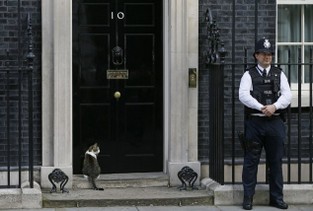
For almost three centuries, since 1731, the building at 10, Downing Street has been the official residence of the Prime Minister. In 1997 Tony Blair, winner of the elections and father of four, moved to the larger apartment at number 11 and left number 10 to Gordon Brown. Ever since Margaret Thatcher became the target of the IRA attacks, the street has not been accessible for transit for security reasons. Gates have also been set up at the two extremities, behind which police cordons are posted.
Before this, it was possible to enter the street and use it as a short cut to St James Park. On the other side of the street stands the Foreign Office.
The street got its name from George Downing, who started his career as army chaplain. During the civil war of the Seventeenth Century, he fought for the Parliament but as soon as he realised that the Restoration of the King was certain, he changed sides.
DOVER HOUSE
WHITEHALL
UNDERGROUND: WESTMINSTER, CHARING CROSS
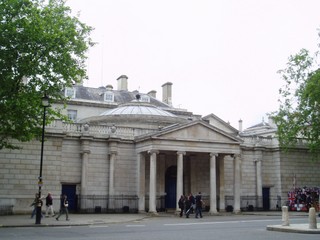 Dover House was built between 1754 and 1758 by James Paine as a private house for Matthew Featherstonehaugh, a member of Parliament for Portsmouth. Since 1885, it has been the headquarters of the Scottish Office, since 1999 for the Scotland Office, with the Secretary of State and the Ministry offices. It is a beautiful building, declared as being of immense architectural interest. Its rear facade faces the Horse Guards Parade.
Dover House was built between 1754 and 1758 by James Paine as a private house for Matthew Featherstonehaugh, a member of Parliament for Portsmouth. Since 1885, it has been the headquarters of the Scottish Office, since 1999 for the Scotland Office, with the Secretary of State and the Ministry offices. It is a beautiful building, declared as being of immense architectural interest. Its rear facade faces the Horse Guards Parade. In 1788, Dover House was acquired by the duke of York, then later it belonged to the Melbourne family. The wife of the first viscount of Melbourne, Lady Caroline Lamb, a brilliant and eccentric woman, had an affair with Lord Byron. She died here in 1828. The name of the house derives from the last private owner, the Baron Dover.
The entrance has a rounded shape which is rather unusual. Like almost all the rest of the building, it was built after the bombardment and reinforced with a structure of hidden steel.
HORSE GUARDS
WHITEHALL
UNDERGROUND: WESTMINSTER
The palace of the Horse Guards is a building which dates back to halfway through the Eighteenth Century and was designed by William Kent. It was built by John Vardy on three sides of a vast courtyard, with sentry boxes in which the soldiers of the Royal Guard are seated immobile on the mounts. The guard changes at 11a.m. and is inspected at 4 p.m.
At the centre of the longest side, there is an arched passage which leads to the Horse Guards Parade, a gravelly stretch where each year in June the Queen receives the salute of the guards on her birthday. It is worth thoroughly exploring the square in order to see the posterior facades of the buildings and to dwell on the cannons, which are remarkable, even by the standards of anyone not particularly interested in such matters. One of these was fabricated in 1524 by Murad, son of Abdullah, in Turkey, and then brought to Europe in 1801.
The other is a French mortar used in the siege of Cádiz in 1812. The wagon upon which it leans is decorated with three marine monsters covered with scales and the crests of the Prince of Wales, to whom it had been gifted. In the north-western corner of the square there is the extraordinary building of the Admiralty Citadel, built during the Second World War as a stronghold for government communications. It resembles a solid rock all covered by Russian vine.
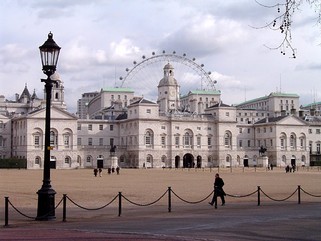 The low colonnade of the courtyard - The outer facade of the building, on the west side, is well known to everyone. It is more interesting to go round the corner and enter the courtyard. The inside area does not have the elegance and the pomposity of the outer area, but with its blended hues and reduced proportions, it is an evocative place to be. The courtyard was built in 1751 by William Kent and John Vardy, responsible for many royal palaces of the epoch. Kent had in fact designed the royal stables of Charing Cross and the palace of the Ministry of the Treasury in Whitehall.
The low colonnade of the courtyard - The outer facade of the building, on the west side, is well known to everyone. It is more interesting to go round the corner and enter the courtyard. The inside area does not have the elegance and the pomposity of the outer area, but with its blended hues and reduced proportions, it is an evocative place to be. The courtyard was built in 1751 by William Kent and John Vardy, responsible for many royal palaces of the epoch. Kent had in fact designed the royal stables of Charing Cross and the palace of the Ministry of the Treasury in Whitehall. Vardy had instead designed the Greenwich Hospital, the Hampton Court palaces, Whitehall, Westminster, and St James. Together, the two architects worked at the Horse Guards.
The painter Hogarth, in a caricature illustration of his, had mocked the entrance arch, seen to be too low for those entering the courtyard on horseback or seated on the coachman's seat. The image showed a coachman about to have his head taken off by the arch...
PAYMASTER - GENERAL OFFICE
1, HORSE GUARDS ROAD
UNDERGROUND: WESTMINSTER
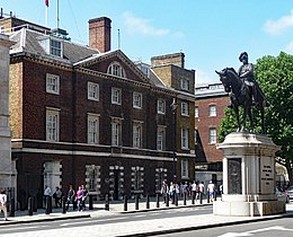 The building where the office of the Paymaster-General (the minister at the head of the Treasury department responsible for payments of pensions and treasurer for most areas), built in 1732 by John Lane, is north of that of Horse Guards. It is a brick building with a window equipped with a lunette above the gable, with a slightly different style to that of the nearby ones. The important posterior facade, with its Venetian-style windows, was added in 1910, and brought here from number 37, Great George Street.
The building where the office of the Paymaster-General (the minister at the head of the Treasury department responsible for payments of pensions and treasurer for most areas), built in 1732 by John Lane, is north of that of Horse Guards. It is a brick building with a window equipped with a lunette above the gable, with a slightly different style to that of the nearby ones. The important posterior facade, with its Venetian-style windows, was added in 1910, and brought here from number 37, Great George Street. CABINET WAR ROOMS
CLIVE STEPS,
KING CHARLES STREET
UNDERGROUND: WESTMINSTER
At the corner of Horse Guards Street, in front of St James's Park, there is a small door around which sacks of sand are heaped. It leads to a labyrinth of underground rooms, the maze of tunnels from where the British government organized the war on Hitler.

On the maps, there are still coloured pins which mark the shifting luck of the conflict. In 1980 the rooms were re-opened to the public, intact and including the area of the typewriters, the dormitory and beds, the table which would host the components of the restricted government organ composed of the main ministers (the Cabinet Room), and Churchill's bedroom... The atmosphere of the place remains unchanged since those days long ago.
AN ADMIRALTY WHICH NO LONGER EXISTS
WHITEHALL
UNDERGROUND: TRAFALGAR SQUARE, CHARING CROSS
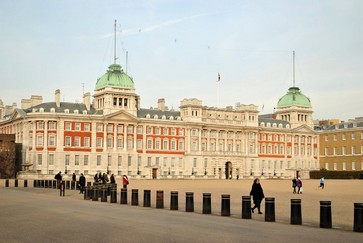 Before the Fifteenth Century there was only one person in command of the Royal Navy. Only during the following centuries was the responsibility of its management shared by a committee. The British Admiralty, which since 1964 has been a part of the Ministry of Defence, which was based in the spectacular Admiralty palace, has a glorious but bloody story, as can be gleaned from Kipling's verses: "If blood the price of admiralty, Lord God, we ha' paid in full!". As we have already mentioned, the Admiralty no longer exists as a department, as it did in the past, when it occupied five buildings located between Whitehall, Horse Guards Parade, and The Mall. The oldest building, still known as Old Admiralty, was built by Ripley in 1726. The three floors shaped as a U are now taken up by the heads of the main government departments. The building is protected from the street by a screen surmounted by representations of beings which are half fish and half horse, a work by Robert Adam. The rooms are solemn and imposing, and the fireplace of the Meeting Room has a splendid decoration in sculpted wood, with branches of flowers and fruit intertwined together with obsolete nautical instruments.
Before the Fifteenth Century there was only one person in command of the Royal Navy. Only during the following centuries was the responsibility of its management shared by a committee. The British Admiralty, which since 1964 has been a part of the Ministry of Defence, which was based in the spectacular Admiralty palace, has a glorious but bloody story, as can be gleaned from Kipling's verses: "If blood the price of admiralty, Lord God, we ha' paid in full!". As we have already mentioned, the Admiralty no longer exists as a department, as it did in the past, when it occupied five buildings located between Whitehall, Horse Guards Parade, and The Mall. The oldest building, still known as Old Admiralty, was built by Ripley in 1726. The three floors shaped as a U are now taken up by the heads of the main government departments. The building is protected from the street by a screen surmounted by representations of beings which are half fish and half horse, a work by Robert Adam. The rooms are solemn and imposing, and the fireplace of the Meeting Room has a splendid decoration in sculpted wood, with branches of flowers and fruit intertwined together with obsolete nautical instruments. TRAFALGAR SQUARE
UNDERGROUND: CHARING CROSS
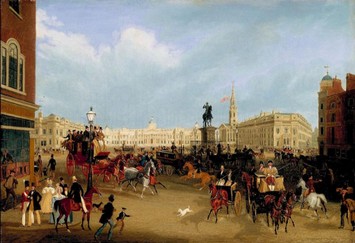 With its pigeons, the spurts of the fountain deviated by the wind, and the padding of peanut shells on which one walks, Trafalgar Square is one of the most renowned and photographed squares in the world.
With its pigeons, the spurts of the fountain deviated by the wind, and the padding of peanut shells on which one walks, Trafalgar Square is one of the most renowned and photographed squares in the world. It is dedicated to the memory of the Battle of Trafalgar, where the Horatio Nelson's Royal Navy defeated the French and Spanish fleets. It is a sloped square, with a discreet difference in height between the two extremities, to the point that, before building the National Gallery there, it was necessary to build a level terrace. At its feet, is a marking of the imperial measurements of the inch, foot, and yard. Until 1830, the royal stables were located here, the King's Mews. On the western side one can find the buildings of the Canada House, built in 1827 by Robert Smirke for the Union Club, and of the Royal College of Physicians. To the east, instead, is the South Africa House by Herbert Baker; its facade is decorated by sculptures of wild African animals.
Through the years, the square has heard the resounding voices of protests. It is a "political" square, a place for demonstrations and processions, ranging from those against the apartheid in South Africa in the 1980s, to those against war and injustice in the world.
In the winter, an enormous Christmas tree is set up in the square, twinned by the one in Grand-Place in Brussels.
From the Trafalgar Hotel café, which stands at the south-western corner of the square (2, Spring Gardens), one can enjoy a pleasant view of the square.
The café stands at the same height as the statue of Nelson, and is open only during summertime, yet it is worth visiting.
STATUE OF CHARLES I
TRAFALGAR SQUARE
UNDERGROUND: CHARING CROSS
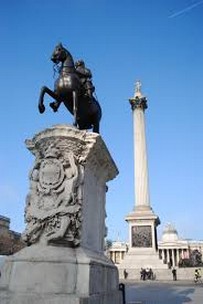 The contrast between Charles I, the king executed in 1625, and Cromwell brought the country to a civil war which lasted six years. Cromwell emerged as the victor of the confrontation and as well as reigning for eleven years, he had the statue of Charles I removed. The bronze monument had been sculpted by Hubert le Sueur, once removed it had been handed over to a brazier in order to be melted. The artisan, however, had buried it in his garden and eleven years later, after the Restoration, he offered it back to the son of Charles I, who compensated him and placed the statue back in its original place.
The contrast between Charles I, the king executed in 1625, and Cromwell brought the country to a civil war which lasted six years. Cromwell emerged as the victor of the confrontation and as well as reigning for eleven years, he had the statue of Charles I removed. The bronze monument had been sculpted by Hubert le Sueur, once removed it had been handed over to a brazier in order to be melted. The artisan, however, had buried it in his garden and eleven years later, after the Restoration, he offered it back to the son of Charles I, who compensated him and placed the statue back in its original place. Still today a group of monarchists recreate, with solemnity and dedication, the last journey of the king (from the Mall, in front of St James's Palace, to the Banqueting House and to Whitehall), which took place on the cold day of January 30th, 1649. The procession takes place with traditional costumes and armour, and happens on the Sunday closest to this date. It proceeds silently, with just the beating of a drum. Once the square is reached, the participants place a bay wreath at the base of the statue and repeat the last word of the king: "Remember!"
Another memory of the execution is to be found on the clock of the Horse Guards Parade facade. Just next to the Roman numeral II, the hour of his execution, there is a small black dot. Near the statue there is a spot from which one calculates the distances to and from London.
NELSON'S PILLAR
TRAFALGAR SQUARE
UNDERGROUND: CHARING CROSS
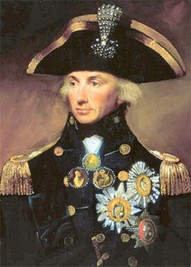 The extremely tall Nelson's Pillar, which looms at the centre of the square, is made of Devonshire granite and is forty-six metres tall. It was erected in 1843, and the lions at its base were drawn by Edwin Landseer and cast almost contemporarily by Baron Marochetti, but installed only in 1868. The capital above it is made with the bronze of cannons subtracted from the French and with that of the rifles of the Royal George. The bronze was also used for the four bas-reliefs at its base, where we can see the representations of Nelson's victories, the battle of Egypt, and that of Trafalgar. On the walls of the pedestal are the busts of the admirals Jellicoe, Cunningham, and Beatty.
The extremely tall Nelson's Pillar, which looms at the centre of the square, is made of Devonshire granite and is forty-six metres tall. It was erected in 1843, and the lions at its base were drawn by Edwin Landseer and cast almost contemporarily by Baron Marochetti, but installed only in 1868. The capital above it is made with the bronze of cannons subtracted from the French and with that of the rifles of the Royal George. The bronze was also used for the four bas-reliefs at its base, where we can see the representations of Nelson's victories, the battle of Egypt, and that of Trafalgar. On the walls of the pedestal are the busts of the admirals Jellicoe, Cunningham, and Beatty. Nelson has an interesting biography. He was taken onboard a ship at the tender age of twelve, despite his suffering from seasickness, under the command of his uncle, who was the captain. He later became a captain himself, then a commodore, and finally an admiral. He fought against Napoleon, destroying the latter's fleet in the battle of the Nile, and once again bested the French fleet in the battle of Trafalgar, where he lost his life. In the state apartments of Windsor Castle, the bullet shot by the French sharpshooter which took his life is still preserved.
At sea with a coffin - In order to avoid a sea burial, which consisted of one's body being thrown into the ocean, Nelson always travelled with a coffin.  Upon his death in Trafalgar, his body was placed inside it and drenched in rum in order to conserve it. In Gibraltar, the coffin was replaced along with the rum. Nelson was buried under the dome of St Paul's, in a black sarcophagus which had been built for Cardinal Wolsey. The sarcophagus had remained abandoned for almost three-hundred years, until it was decided that it be used for Nelson. The mitre was removed from within, but the purple cushion in velvet which sustains the crown was left inside it. His last wishes, namely that his titles and honour should be passed down to Emma Hamilton, were not followed.
Upon his death in Trafalgar, his body was placed inside it and drenched in rum in order to conserve it. In Gibraltar, the coffin was replaced along with the rum. Nelson was buried under the dome of St Paul's, in a black sarcophagus which had been built for Cardinal Wolsey. The sarcophagus had remained abandoned for almost three-hundred years, until it was decided that it be used for Nelson. The mitre was removed from within, but the purple cushion in velvet which sustains the crown was left inside it. His last wishes, namely that his titles and honour should be passed down to Emma Hamilton, were not followed. 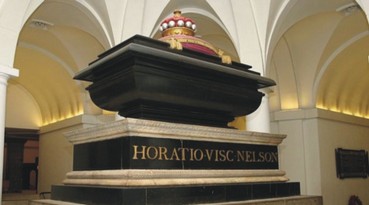 Nelson had met Emma in Naples, and she had become his lover and had given him a daughter, Horatia. Through the years, many people have climbed the tower in order to bring the attention of the public to focus on certain social or political issues. One of these was a stuntman who launched himself off the top with a parachute, hoping to stir public opinion regarding the occupation of Tibet.
Nelson had met Emma in Naples, and she had become his lover and had given him a daughter, Horatia. Through the years, many people have climbed the tower in order to bring the attention of the public to focus on certain social or political issues. One of these was a stuntman who launched himself off the top with a parachute, hoping to stir public opinion regarding the occupation of Tibet.
 Upon his death in Trafalgar, his body was placed inside it and drenched in rum in order to conserve it. In Gibraltar, the coffin was replaced along with the rum. Nelson was buried under the dome of St Paul's, in a black sarcophagus which had been built for Cardinal Wolsey. The sarcophagus had remained abandoned for almost three-hundred years, until it was decided that it be used for Nelson. The mitre was removed from within, but the purple cushion in velvet which sustains the crown was left inside it. His last wishes, namely that his titles and honour should be passed down to Emma Hamilton, were not followed.
Upon his death in Trafalgar, his body was placed inside it and drenched in rum in order to conserve it. In Gibraltar, the coffin was replaced along with the rum. Nelson was buried under the dome of St Paul's, in a black sarcophagus which had been built for Cardinal Wolsey. The sarcophagus had remained abandoned for almost three-hundred years, until it was decided that it be used for Nelson. The mitre was removed from within, but the purple cushion in velvet which sustains the crown was left inside it. His last wishes, namely that his titles and honour should be passed down to Emma Hamilton, were not followed. THE POLICE STATION IN TRAFALGAR SQUARE
UNDERGROUND: CHARING CROSS
Today auxiliary police stations have all but vanished almost everywhere, however in the past metropolitan police agents who were on patrol would maintain contact with the local police station through a number of miniature offices which were distributed throughout the city in strategic spots, and which could be used as backup bases. At the top of these small stations there is a blue light similar to those found on police cars.
The one in Trafalgar Square, built into the base of a lamp post, of which it resembles the pillar, is very well camouflaged. It was installed in the 1930s, in order to supervise protesters. There was room for one policeman, providing he were not too robust, and in the sentry box there was also a telephone in case events ended up getting out of hand. Today this space has other uses, amongst which the deposit of materials for cleaning the square.
NATIONAL GALLERY
TRAFALGAR SQUARE
UNDERGROUND: CHARING CROSS
Amongst them, are the works of Duccio, Giotto, Masaccio, Piero della Francesca, and Paolo Uccello. It is said that The Battle of San Romano, which portrays the people of Florence chasing the fleeing people of Siena during a conflict, was hung up in the bedroom of Lorenzo De' Medici. On the piano nobile, there is one of the two versions of the Virgin of the Rocks (the other is in the Louvre). It has been inserted into a frame which has been made by joining the fragments of a framework from that epoch. It was purchased by the English painter Gavin Hamilton, who in 1880 sold it to the museum. Also by Leonardo, is the The Virgin and Child with St Anne and St John the Baptist, the preparatory drawing created with black chalk, white lead and a blending stump, which shows the characters mentioned in its title. By Michelangelo, instead, is The Deposition, an unfinished painting which shows Christ being taken to the Sepulchre and the disciples' effort to hold up the weight of his body. There are also many paintings by Titian, in different rooms: The Bacchus and Ariadne, the Noli me tangere, Madonna and Child, Portrait of the Vendramin Family, The Tribute, The Allegory of Prudence, The Death of Actaeon, The Holy Family with a Shepherd, Portrait of a man, and La Schiavona. By Botticelli, there is the painting of Venus and Mars, with the latter asleep by her side, and some small fauns who have got hold of the spear belonging to the god of war. Also by Botticelli is the Adoration of the Magi. In Bellini's portrait of Leonardo Loredan, the peaceful dignity of the Doge of Venice comes to life through his strict stare. One of the most sought after paintings, which is sometimes the object of exhibitions, is the Supper at Emmaus by Caravaggio. The emotional reactions of the apostles as they recognize the resurrected Jesus (one of them stretches his arms wide open, another grips the armrest of his chair as if he were about to bound forward) impress the idea of miracles in the context of daily life. Also some accurate details, such as the glass jug, the scrawny-legged chicken, the fruit basket precariously sitting on the edge of the tabletop, and the chairs all around, all bring the painted world to life and transport us into it.
Also French art is well represented, with paintings by Poussin, Watteau, Ingres, Delacroix, Manet, Cézanne, Monet, and Renoir.
THE AWAKENING OF THE MODERN MUSES
HALL OF THE NATIONAL GALLERY
TRAFALGAR SQUARE
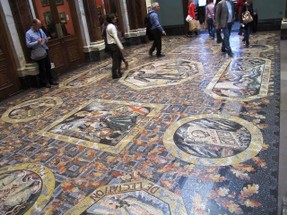 The floor of the main entrance and of the lateral vestibules of the National Gallery is covered in mosaics, carried out between 1928 and 1952 by Boris Anrep, who is also the author of the mosaics in the Blake Room at the Tate Britain, along with others in Westminster Cathedral. Using a particular technique and colours inspired by the Byzantine hues, Anrep depicted The Awakening of the Muses, symbolized by modern characters.
The floor of the main entrance and of the lateral vestibules of the National Gallery is covered in mosaics, carried out between 1928 and 1952 by Boris Anrep, who is also the author of the mosaics in the Blake Room at the Tate Britain, along with others in Westminster Cathedral. Using a particular technique and colours inspired by the Byzantine hues, Anrep depicted The Awakening of the Muses, symbolized by modern characters.The goddesses of Greek-Roman mythology protected the arts and literature, and the women represented by Anrep are their personification. The writer Virginia Woolf represents Clio, whereas the actress Greta Garbo is Melpomene, the muse of Tragedy. Upon the floor of the northern vestibule, there are reproductions of the modern virtues. The Russian poetess Anna Achmatova represents Compassion. Churchill is shown warding off a monster in the shape of a swastika and represents Defiance, whereas the dancer Margot Fonteyn is the incarnation of Delectation. Lest we forget that these mosaics have an ironic undertone to them, the poet T.S. Eliot has been represented as the symbol of Leisure, and is shown as he ponders one of Einstein's formulas, whilst behind him a young girl brawls with the Loch Ness Monster. Finally, the philosopher Bertrand Russell incorporates mental Lucidity.
An interesting fact is that the artist did not create the mosaics on the spot, but assembled the tiles on drawings that he had prepared in his private study. He then transported them here and plastered them to the floor.
At the bottom of the staircase which leads to the museum, there are some small copper plaques which bear the engravings of the British measurement units of the inch, foot, and yard.
NATIONAL PORTRAIT GALLERY
2, ST MARTIN'S PLACE
UNDERGROUND: CHARING CROSS
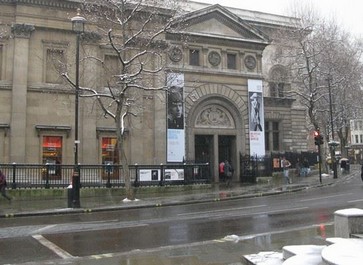 A visit to the National Portrait Gallery allows one to get an idea of British history through the characters who determined it. The gallery was founded in 1856 with the aim of gathering the portraits of writers, painters, politicians, sports celebrities, and actors, even ranging to today's rock stars. It was redesigned by the Dixon Jones studio, the architects of the Royal Opera House. Some of the paintings are very formal, others are caricatures. There are around ten thousand portraits and since 1968 photographs have been added too. They are displayed in chronological order, starting from the top floor down to the basement.
A visit to the National Portrait Gallery allows one to get an idea of British history through the characters who determined it. The gallery was founded in 1856 with the aim of gathering the portraits of writers, painters, politicians, sports celebrities, and actors, even ranging to today's rock stars. It was redesigned by the Dixon Jones studio, the architects of the Royal Opera House. Some of the paintings are very formal, others are caricatures. There are around ten thousand portraits and since 1968 photographs have been added too. They are displayed in chronological order, starting from the top floor down to the basement. The first portrait is that of King Henry VII and was carried out in 1505. Amongst the most moving works is the portrait of the three Brontë sisters, carried out by their brother. One of the smaller paintings is that of Francis Drake. A thorough visit requires half a day's time. One can then make one's way to the restaurant on the top floor, where one can enjoy a pleasant view of the Parliament palace. In front of the gallery stands a statue of Edith Cavell, the nurse who saved so many lives and was killed by the Germans in Schaerbeek, in Belgium.
At number 35, St Martin's Street, just behind the National Portrait Gallery, is the Westminster Art Reference Library for those operating professionally in the field of art and design, but it can also be visited by people who are simply passionate about art... It is not all that huge, however it contains collections of books on the subjects of art, design, show business, and is open to the general public.
CHURCH OF ST MARTIN-IN-THE-FIELDS
2, ST MARTIN'S PLACE
UNDERGROUND: CHARING CROSS
The name refers to the position of the church which in 1222, the date of its first construction, stood in the middle of the fields. Centuries later, the parish was expanded by Henry VIII, who did not wish for funerals to cross Whitehall on their way to St Margaret's cemetery. St Martin's was rebuilt for the last time in 1726. Dating back to such a date are the magnificent colonnade with six great Corinthian pillars, the remarkable gable, the great bell tower, and the elaborate steeple, which together reach a height of fifty-six metres.
The inside area includes three naves with a barrel vault, the Corinthian pillars are gigantic, and there are galleries above the lateral naves. A huge organ is present. The plaster decoration which forms the relief ornamentation and the frames are of Italian taste, and were carried out by Artari and Bugatti. The alms tray, of extraordinary beauty, is preserved at the Victoria & Albert Museum.
The church hosts many classical concerts and one may happen to witness a live exhibition of the Academy of St Martin-in-the-Fields, whose recordings are famous worldwide. At lunchtime, emerging artists often play.
On Easter Monday, baptisms are celebrated. It is entertaining to see such a number of newborn wrapped up in white lace dresses, who are then brought from the wooden alcoves at the sides of the church to the baptismal fount, and to watch their expressions as the water touches their foreheads. Some cry desperately, others seem more interested in trying to seize the spectacles of the celebrant...
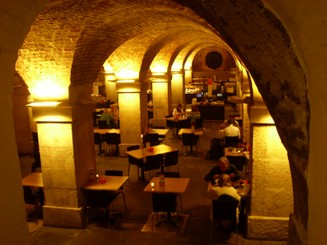 Do not miss out on descending into the crypt for a drink of coffee, a sandwich, or to recover your energy with a delicious hot dish of soup. Just nearby, there is a laboratory open to the public, where one can purchase sheets of paper and colours so that one can make some so-called rubbings, which are images reproduced on the paper by rubbing through it onto items from the splendid collection of engraved objects, incisions, and small wooden blocks. Children will absolutely adore this. In the courtyard at the back of the church, there is a small open-air market, with stands selling jewellery, posters, and other trinkets.
Do not miss out on descending into the crypt for a drink of coffee, a sandwich, or to recover your energy with a delicious hot dish of soup. Just nearby, there is a laboratory open to the public, where one can purchase sheets of paper and colours so that one can make some so-called rubbings, which are images reproduced on the paper by rubbing through it onto items from the splendid collection of engraved objects, incisions, and small wooden blocks. Children will absolutely adore this. In the courtyard at the back of the church, there is a small open-air market, with stands selling jewellery, posters, and other trinkets. 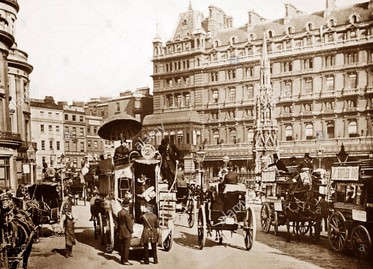 The Strand's function was that of connecting the City to Westminster, through the village of Charing. Already during the Middle Ages, but also in the Tudor and Stuart epoch, prelates and nobles had built their houses along this lush street, with many orchards and gardens descending down towards the Thames, where the salmon would swim. In old maps, one can see how each residence on the Strand (the name meaning "the edge") was made up of a series of houses encircling a courtyard. Later, at the end of the Seventeenth Century, the nobles began to sell their properties in order to move to St James. The houses and lands were subdivided and smaller houses were built. Only the names of the streets kept their connection with the aristocratic families. Thence the names George Street, Villiers Street, Duke Street, York Place, and Buckingham Street, the latter clearly connected to the royal family. Number 10, Villiers Street, was inhabited in 1766 by the philosophers David Hume and Jean-Jacques Rousseau. Number 43, which at the time was actually number 9, was Rudyard Kipling's home, and is where he wrote The Light that Failed. During the Victorian Age, the street was filled with theatres, such as the Romano, the Gatti, and the Gaiety, as well as restaurants, and luxury boutiques. It was an extremely lively street, always trodden, both at day and by night, by the hooves of horses pulling coaches.
The Strand's function was that of connecting the City to Westminster, through the village of Charing. Already during the Middle Ages, but also in the Tudor and Stuart epoch, prelates and nobles had built their houses along this lush street, with many orchards and gardens descending down towards the Thames, where the salmon would swim. In old maps, one can see how each residence on the Strand (the name meaning "the edge") was made up of a series of houses encircling a courtyard. Later, at the end of the Seventeenth Century, the nobles began to sell their properties in order to move to St James. The houses and lands were subdivided and smaller houses were built. Only the names of the streets kept their connection with the aristocratic families. Thence the names George Street, Villiers Street, Duke Street, York Place, and Buckingham Street, the latter clearly connected to the royal family. Number 10, Villiers Street, was inhabited in 1766 by the philosophers David Hume and Jean-Jacques Rousseau. Number 43, which at the time was actually number 9, was Rudyard Kipling's home, and is where he wrote The Light that Failed. During the Victorian Age, the street was filled with theatres, such as the Romano, the Gatti, and the Gaiety, as well as restaurants, and luxury boutiques. It was an extremely lively street, always trodden, both at day and by night, by the hooves of horses pulling coaches. Today Strand is a mixture of buildings from the Nineteenth and Twentieth Century, which host shops, offices, banks, hotels, and theatres. On the northern side stands the Lyceum Theatre, whose remodelled gallery saw the triumph of Henry Irving. Today it is used as a dance hall. Nearby are the Vaudeville and Adelphi Theatre. At number 39, the company Stanley Gibbons sells stamps, whereas at the nearby post office, at numbers 24-28, William IV Street, one can find stamps for collectors and those issued on occasion of special events and commemorations. If you are collectors, a trip there is a must.
CHARING CROSS STATION AND THE SURROUNDING AREA
STRAND
UNDERGROUND: CHARING CROSS
The original station stood on the area of the Hungerford market. It had been designed by John Hawkshaw and opened in 1864. Hawkshaw built it with a single-bay roof for all of the six platforms. Unfortunately, forty years later, it collapsed. The present building is extremely modern and its walls are covered in wall art which retraces its history. The name is a mangling of the French Chère Reine (Dear Queen). At the time, French was the language of the court, and although the Queen was of Spanish origin, the French name was used.
At number 25, Northumberland Avenue, the great arterial road built in 1874 at the corner with the station, stands the Commonwealth Society. It was born as a colonial society, with particular attention placed on India. Today it promotes diversity, tolerance, freedom, justice, democracy, and human rights through international meetings. Moreover, it helps young people to develop their skills in the fields of art, writing, and cinema. It has an excellent library with an important collection of photographs.
At number 10 of the nearby Northumberland Street, there is a pub called The Sherlock Holmes. The pub is full of souvenirs regarding the famous detective, which give it the atmosphere of a small museum. They are mostly objects which were part of a travelling exhibit, and were then bought by the pub owner. It is a reproduction of the living room, completely furnished according to the taste of the Nineteenth Century. It can be seen from the restaurant, behind the glass wall.
ELEANOR CROSS
CHARING CROSS
UNDERGROUND: CHARING CROSS
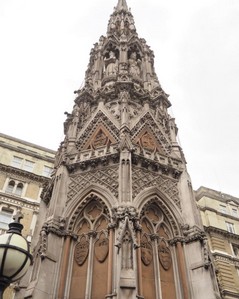 In 1865, in the courtyard in front of the station, a replica of the Eleanor Cross was built, based on the Whitehall Cross which dates back to the Eighteenth Century and was demolished in 1647 and stood where the statue of Charles I now stands, from where distances to and from London are measured. It was comprised of twelve sculpted stone monuments, three of which have survived intact, placed along a path to the east of England. King Edward I had them erected between 1291 and 1294 as a memory of his wife Eleanor of Castille, by marking the nocturnal stops of the funeral procession which took place while her body was being transported to London. There is also one rather macabre detail: The Queen died in 1290 near Lincoln, where she was embalmed. Her guts were buried in the Angel Choir of the city cathedral, whereas the rest of her body was buried in Westminster, at the feet of her father-in-law, Henry III. Her heart, instead, was buried in the abbey church of Blackfriars. The funeral monuments had the purpose of places of prayer for pilgrims and travellers.
In 1865, in the courtyard in front of the station, a replica of the Eleanor Cross was built, based on the Whitehall Cross which dates back to the Eighteenth Century and was demolished in 1647 and stood where the statue of Charles I now stands, from where distances to and from London are measured. It was comprised of twelve sculpted stone monuments, three of which have survived intact, placed along a path to the east of England. King Edward I had them erected between 1291 and 1294 as a memory of his wife Eleanor of Castille, by marking the nocturnal stops of the funeral procession which took place while her body was being transported to London. There is also one rather macabre detail: The Queen died in 1290 near Lincoln, where she was embalmed. Her guts were buried in the Angel Choir of the city cathedral, whereas the rest of her body was buried in Westminster, at the feet of her father-in-law, Henry III. Her heart, instead, was buried in the abbey church of Blackfriars. The funeral monuments had the purpose of places of prayer for pilgrims and travellers. DAVENPORTS MAGIC SHOP
7, CHARING CROSS
UNDERGROUND SHOPPING ARCADE
UNDERGROUND: CHARING CROSS
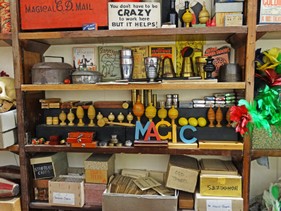 On Strand, in the crowded trade gallery, there is a magic shop. The small store, which opened in 1898, bears the name of the forefather of the dynasty, the illusionist and juggler, Lewis Davenport, who amongst his successful acts, would juggle with flaming balls. The shop is aimed at amateur magicians who wish to dazzle their friends in household shows, but also at professional conjurers. There is truly every type of product, from the basic tools of the trade (coins and magic cards, for example), to videos and books for learning, as well as parlour or table games. There are even courses that can be attended.
On Strand, in the crowded trade gallery, there is a magic shop. The small store, which opened in 1898, bears the name of the forefather of the dynasty, the illusionist and juggler, Lewis Davenport, who amongst his successful acts, would juggle with flaming balls. The shop is aimed at amateur magicians who wish to dazzle their friends in household shows, but also at professional conjurers. There is truly every type of product, from the basic tools of the trade (coins and magic cards, for example), to videos and books for learning, as well as parlour or table games. There are even courses that can be attended. THE BRITISH OPTICAL ASSOCIATION MUSEUM
AND THE BENJAMIN FRANKLIN MUSEUM
42, CRAVEN STREET
UNDERGROUND: CHARING CROSS
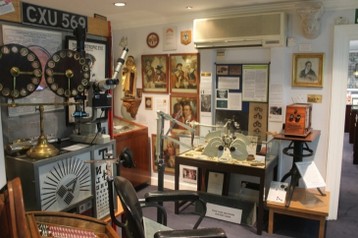 The collection of objects related to optical science and healthcare is vast. There are as many as thirteen thousand of them, and amongst them are many small treasures of historical importance. The opticians' association was founded in 1895, and the museum was opened six years later. There are spectacles with sidepieces, springs, for the short-sighted or far-sighted, prismatic glasses, sunglasses, underwater glasses, smoked glass spectacles, protective wear, coloured types, monocles, binoculars, wig spectacles, lorgnettes, pince-nez, and the list goes on...
The collection of objects related to optical science and healthcare is vast. There are as many as thirteen thousand of them, and amongst them are many small treasures of historical importance. The opticians' association was founded in 1895, and the museum was opened six years later. There are spectacles with sidepieces, springs, for the short-sighted or far-sighted, prismatic glasses, sunglasses, underwater glasses, smoked glass spectacles, protective wear, coloured types, monocles, binoculars, wig spectacles, lorgnettes, pince-nez, and the list goes on... There is also an Egyptian talisman: an Eye of Horus which according to tradition allows one to see into the afterlife.
At number 36 in the same street, one can visit the House-museum of Benjamin Franklin, who invented the lightning rod as well as bifocal lenses. Built in 1730, the building with its simple facade in dark bricks hosted Franklin from 1757 to 1775.
Students may attend scientific experiments being carried out. Visitors are invited to offer their personal interpretations of a famous phrase by the scientist, who was also a diplomat, philosopher, inventor, and founding father of the United States. The phrase is changed each year. The last one to appear was "Light often arises from a collision of opinions, as fire from flint and steel".
In 1827, in a cold apartment near Craven Street, lived the German poet Heinrich Heine, who had been reduced to the bleakest misery. On the subject of misery, just next to the nearby Hungerford Stairs, there was a shoe polish factory where Charles Dickens worked when his father was in prison for debts. This experience is described in the eleventh chapter of David Copperfield.
ADELPHI
STRAND
UNDERGROUND: EMBANKMENT, CHARING CROSS
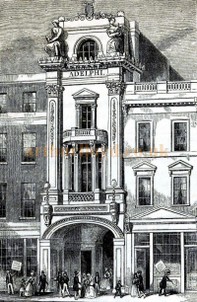 The adelphi, meaning the "brothers", according to the Greek meaning of the word, were the architects Robert and James Adam. In 1774, they decided to improve the appearance of the neighbourhood of Strand, at the time rather degraded, and to give their constructions such title.
The adelphi, meaning the "brothers", according to the Greek meaning of the word, were the architects Robert and James Adam. In 1774, they decided to improve the appearance of the neighbourhood of Strand, at the time rather degraded, and to give their constructions such title. 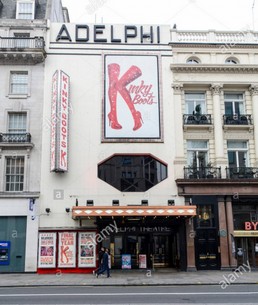 The latter were made up of two rows of eleven houses each. Due to a lack of money during the course of the construction, the two brothers decide to resort to the lottery. The facades of the houses between the Thames and Strand were adorned with statues and pillars, in accordance with the Georgian style. Unfortunately, in 1936, the statues were mutilated. One can get an idea of how these buildings that no longer exist must have been, by observing the building at number 7, Adam Street, where the offices of Lancet are today, the important medical magazine which is popular all over the world.
The latter were made up of two rows of eleven houses each. Due to a lack of money during the course of the construction, the two brothers decide to resort to the lottery. The facades of the houses between the Thames and Strand were adorned with statues and pillars, in accordance with the Georgian style. Unfortunately, in 1936, the statues were mutilated. One can get an idea of how these buildings that no longer exist must have been, by observing the building at number 7, Adam Street, where the offices of Lancet are today, the important medical magazine which is popular all over the world. YORK WATERGATE
THAMES EMBANKMENT GARDENS
UNDERGROUND: EMBANKMENT
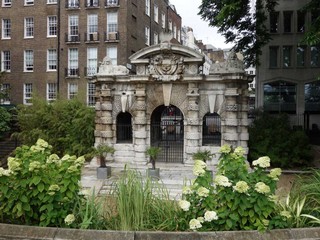 Watergate, or as it should be pronounced, "water-gate", with the literal meaning of a sluice gate, was the jetty for the docking of the Duke of Buckingham's barge. It was built in 1626 by Nicholas Stone, and placed in front of York House. Today it is situated in the Victoria Embankment Gardens and no longer on the banks, as the Thames has become narrower in this spot. The structure has three bays with large pillars, formed by bossage, structures of carved protruding stone used in Roman, medieval, and Renaissance architecture. At the centre there is a coat of arms, belonging to the Duke of Buckingham.
Watergate, or as it should be pronounced, "water-gate", with the literal meaning of a sluice gate, was the jetty for the docking of the Duke of Buckingham's barge. It was built in 1626 by Nicholas Stone, and placed in front of York House. Today it is situated in the Victoria Embankment Gardens and no longer on the banks, as the Thames has become narrower in this spot. The structure has three bays with large pillars, formed by bossage, structures of carved protruding stone used in Roman, medieval, and Renaissance architecture. At the centre there is a coat of arms, belonging to the Duke of Buckingham. THE ROYAL SOCIETY OF ARTS
8, JOHN ADAM STREET
UNDERGROUND: EMBANKMENT
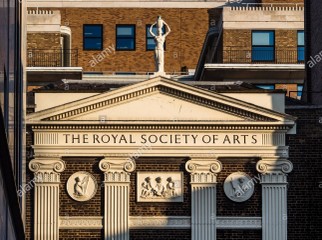 The palace which hosts the Society of Arts is the only part of the architectural design by the Adam brothers to have survived intact. It gives an idea of the original magnificence of the buildings
The palace which hosts the Society of Arts is the only part of the architectural design by the Adam brothers to have survived intact. It gives an idea of the original magnificence of the buildingsThe society was founded in 1754 under the title Society for the Encouragement of the Arts, Manufacturers and Commerce. The aim was that of improving the level of arts, industry, and trade, through competition and the organization of contests. The house the Adam brothers built in 1772 for the association has a large entrance, a reading hall, and a library. On the frieze of the facade one reads the words "Arts and Commerce are promoted", to which the association continues to be loyal. In the reading hall, a written maxim declares: "Happiness, as well individual as public, depends on cultivating the human faculties". One can hardly disagree.
GORDON'S WINE BAR
47, VILLIERS STREET
(A CROSS STREET OF STRAND)
UNDERGROUND: EMBANKMENT, CHARING CROSS
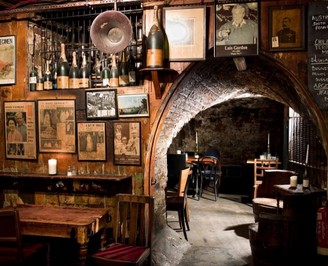 Gordon's Wine Bar, which is situated in a cross street of The Strand, is the oldest winery in London. It was opened in 1890 and has remained the same as it was then. The underground space, accessible via a narrow flight of steps, oozes with atmosphere and has nothing to do with the vivid colours and shimmering metal of modern pubs. From the opposite side of the entrance, one exits onto a shadowy boulevard, where one can stop to sip a glass of good wine or sherry. In the Summer, in this eighteenth-century environment, amid candles which toss their feeble light against the dark, damp arches, one may listen to live jazz ensembles. On the walls, posters are hung, dating back to the Forties and Fifties, as well as printed material.
Gordon's Wine Bar, which is situated in a cross street of The Strand, is the oldest winery in London. It was opened in 1890 and has remained the same as it was then. The underground space, accessible via a narrow flight of steps, oozes with atmosphere and has nothing to do with the vivid colours and shimmering metal of modern pubs. From the opposite side of the entrance, one exits onto a shadowy boulevard, where one can stop to sip a glass of good wine or sherry. In the Summer, in this eighteenth-century environment, amid candles which toss their feeble light against the dark, damp arches, one may listen to live jazz ensembles. On the walls, posters are hung, dating back to the Forties and Fifties, as well as printed material. STATUE OF OSCAR WILDE
STRAND
UNDERGROUND: TEMPLE
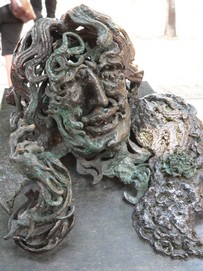 In his comedies, Oscar Wilde struck out against the hypocrisy of the Victorian Society. The great writer of comedies had in fact been a victim of such hypocrisy, having been seen at first as an idol, only to later become a scapegoat. He was tried and condemned for homosexuality to two years of forced labour. When he finally got out of Reading prison, his health was compromised. Gone and far in the past were the days when he would keep lobsters in his room as pets, and use teacups only if white and light blue and made in porcelain. His sufferings are told in the Ballad of Reading Gaol. Wilde then went to live in Paris, under the false name of Sebastian Melmouth, and lived there until his death, inside a squalid hotel.
In his comedies, Oscar Wilde struck out against the hypocrisy of the Victorian Society. The great writer of comedies had in fact been a victim of such hypocrisy, having been seen at first as an idol, only to later become a scapegoat. He was tried and condemned for homosexuality to two years of forced labour. When he finally got out of Reading prison, his health was compromised. Gone and far in the past were the days when he would keep lobsters in his room as pets, and use teacups only if white and light blue and made in porcelain. His sufferings are told in the Ballad of Reading Gaol. Wilde then went to live in Paris, under the false name of Sebastian Melmouth, and lived there until his death, inside a squalid hotel. His statue at Strand is the work of Maggi Hambling. It was discovered by the writer's son, Cyril, and his nephew, Merlin Holland. It is one of the ugliest sculptures conceivable. Such a great comedy writer would have deserved better.
THE STATUE OF HENRY IRVING
CHARING CROSS ROAD
UNDERGROUND: CHARING CROSS
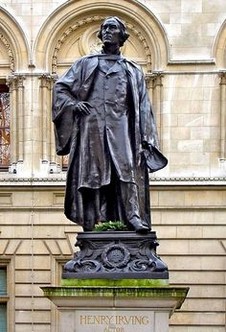 The Shakespearean actor, Henry Irving, who was famous during the Victorian Age, was in truth John Henry Bodribb. He is the only actor to have his own statue in London. He was also knighted, although at first he refused this honour. He stated that he was above such tributes, only to change his mind later, accepting to be fitted with this certificate of merit. He died on stage, pronouncing the words: "Into thy Hands, O Lord..." from Tennyson's Becket.
The Shakespearean actor, Henry Irving, who was famous during the Victorian Age, was in truth John Henry Bodribb. He is the only actor to have his own statue in London. He was also knighted, although at first he refused this honour. He stated that he was above such tributes, only to change his mind later, accepting to be fitted with this certificate of merit. He died on stage, pronouncing the words: "Into thy Hands, O Lord..." from Tennyson's Becket. Each year, on February 11th, on his birthday, the Irving Society commemorates him by placing a bay wreath on the statue's head. As the sculpture is rather tall, this feat is not quite so simple. The statue was carried out by Thomas Brock and discovered in 1910. The actor, with his fine features and strict expression, is portrayed with a vast cape over his frock coat. His right hand rests on his hip with a flexed elbow jutting out to the side.
SEWER GAS VENTILATION LAMPS
CARTING LANE
UNDERGROUND: CHARING CROSS
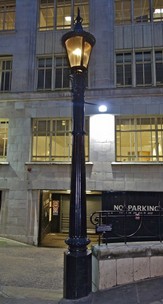 The history of gas illumination is most interesting. Through the centuries, the materials used to develop it were many, depending on the country. At first, gas was obtained by distilling bituminous coal, the fossil carbon found in nature and in particular within bones. Also the systems for transporting it varied from state to state. In China, the combustible gases given by natural emissions were carried great distances within bamboo.
The history of gas illumination is most interesting. Through the centuries, the materials used to develop it were many, depending on the country. At first, gas was obtained by distilling bituminous coal, the fossil carbon found in nature and in particular within bones. Also the systems for transporting it varied from state to state. In China, the combustible gases given by natural emissions were carried great distances within bamboo.The lamp in Carting Lane allowed the gas in the sewers to rise up into the lamp. Here these gases were burned safely, whilst illuminating the street. Today only one of these remains, and is connected to the gas network, therefore having a greenish light.
SAVOY CHAPEL
SAVOY HILL
UNDERGROUND: CHARING CROSS
Savoy Chapel is located within the Adelphi, near the great Shell-Mex House. It was here that Peter of Savoy, the maternal uncle of Eleanor of Provence, wife of King Henry III, built a great palace. It was later demolished in 1817, when the Waterloo bridge construction commenced. The Savoy House descended from Humbert I, Count of Sabaudia or Maurienne, who had become count in 1032.
Piedmont was annexed to Sabaudia subsequently. The name then evolved into Savoy, Savoie, and Savoia, depending on the country. Count Peter of Savoy, who had accompanied his niece to London was also nominated Count of Richmond by the King of England. This also involved a donation of the land between Strand and the Thames, where he built his palace.
SAVOY THEATRE
SAVOY COURT, STRAND
UNDERGROUND: CHARING CROSS
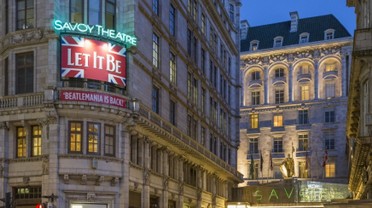 Of the sacred sixteenth-century building, which was originally the Queen's private chapel, not much remains. Unfortunately, halfway through the Nineteenth Century it was almost destroyed by a fire. In 1937, the small church became the chapel of the Royal Victorian Order, founded in 1896, and which still uses it to date. The walls are covered by wooden panels, and there is a Florentine painting inside. High-level concerts are held inside.
Of the sacred sixteenth-century building, which was originally the Queen's private chapel, not much remains. Unfortunately, halfway through the Nineteenth Century it was almost destroyed by a fire. In 1937, the small church became the chapel of the Royal Victorian Order, founded in 1896, and which still uses it to date. The walls are covered by wooden panels, and there is a Florentine painting inside. High-level concerts are held inside. The theatre was opened on October 10th of the same year, with an opera by Gilbert and Sullivan, Patience, transferred from the Opera Comique. It was the first public building to have incandescent electrical lighting. The theatre was then rebuilt in 1929 and once again opened with an opera by Gilbert and Sullivan: this time The Gondoliers. In 1990, the theatre caught fire once more and was yet again rebuilt. Since then, there have been concerts and other events, such as chess encounters and prose.
SAVOY HOTEL
STRAND
UNDERGROUND: CHARING CROSS
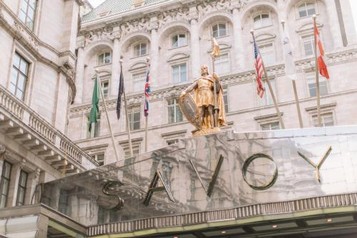 The Savoy is a prestigious five-star hotel and staying the night is a tad on the costly side. However its beauty and opulence can be admired from the outside, and if the porter allows it, one may get to admire the hall. The hotel was built in 1889 by the owner of the next-door theatre, upon the land owned by Count Peter of Savoy. For this reason, the hotel goes by this name. The Savoy was the first hotel to have electric lifts and bathrooms in each and every room.
The Savoy is a prestigious five-star hotel and staying the night is a tad on the costly side. However its beauty and opulence can be admired from the outside, and if the porter allows it, one may get to admire the hall. The hotel was built in 1889 by the owner of the next-door theatre, upon the land owned by Count Peter of Savoy. For this reason, the hotel goes by this name. The Savoy was the first hotel to have electric lifts and bathrooms in each and every room.The first director was César Ritz, who later became famous for the hotel which he opened naming it after himself. During the Second World War, Winston Churchill and his ministers would come to eat here. Here, Queen Elizabeth II showed herself for the first time in public with Prince Philip, her future husband. Some of the most illustrious guests to ever have visited include the painter Claude Monet, and the writer Oscar Wilde, who used to visit the place in the company of Lord Douglas. In time, the hotel has been visited by actors, singers, and show business celebrities. Some of the latter are Sarah Bernhardt, Charlie Chaplin, Marilyn Monroe, and Jimi Hendrix. In the kitchen, the Savoy Grill, the chef Escoffier created Melba Peaches, in honour of the famous singer Nellie Melba.
One may come here for a high tea or for Sunday brunch, or why not, for dinner on Christmas Eve. If on such an occasion, one happens to form a party of thirteen at the table, in order to keep the bad luck away, a fourteenth dinner guest is placed at the table, namely Kaspar, a black alabaster cat who is almost a meter tall. On Savoy Street, the short dead-end street between Strand and the hotel, one drives on the right. This was decided in order to make life more simple for taxi and limousine drivers, who therefore do not have to walk all the way around the car in order to open the back door.
SOMERSET HOUSE
150, STRAND
UNDERGROUND: TEMPLE, EMBANKMENT
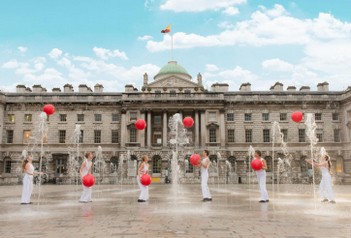 Somerset House was built in 1776 on the area of the ancient sixteenth-century palace belonging to the Duke of Somerset. In order to erect his palace, the duke had razed many private and religious buildings. The neo-classical facade, almost twenty-five meters in length, with Victorian-style wings to the north and south, was designed by William Chambers. It is supported by dark arches, inspired by Piranesi, and until the previous century was touched by the waters of the Thames.
Somerset House was built in 1776 on the area of the ancient sixteenth-century palace belonging to the Duke of Somerset. In order to erect his palace, the duke had razed many private and religious buildings. The neo-classical facade, almost twenty-five meters in length, with Victorian-style wings to the north and south, was designed by William Chambers. It is supported by dark arches, inspired by Piranesi, and until the previous century was touched by the waters of the Thames. The London Treaty, which brought an end to the Anglo-Hispanic war which had lasted twenty years, was signed here on 28th August, 1604. Because of this, the negotiation is known as The Conference of Somerset House. At the entrance, there are audio-visual guides with the history of the building, which through the centuries, has had various destinations and hosted important cultural associations.
The paved courtyard is named Fountain Court and has been restored with great care. It contains a statue of George III and one of the river Thames, by John Bacon. On the northern facade there are arches over the pavement, and in the central keystone, the Ocean is depicted with the rivers that flow into it. One can make out the Severn, the Tyne, the Tweed, and the Medway on the left, and the Thames, the Humber, the Mersey, and the Dee on the right. The rivers were engraved by Joseph Wilton and Agostino Carlini.
Through the courtyard one can access Waterloo Bridge directly, to the east. Just outside the palace, there stands a café with a pleasant outside table area, where one can sip some tea whilst allowing one's gaze to wander over the waters of the Thames.
THE COURTAULD GALLERY
SOMERSET HOUSE STRAND
UNDERGROUND: TEMPLE
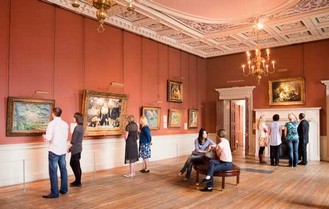 The Courtauld collection, hosted by Somerset House, is not exceedingly vast, however the paintings which comprise it are all of great quality. It is the result of donations and bequests. The paintings range from the Renaissance to the Twentieth Century, from the old masters to impressionists and post-impressionists. There are paintings by Michelangelo, Rubens, Rembrandt, Turner, Van Gogh (the famous Self-portrait with Bandaged Ear), Renoir, Monet, and Picasso. As well as the paintings, there are drawings, printed material, bas-reliefs, and statues. There are sculptures by Rodin and Moore. A whole room is dedicated to paintings of ballerinas, bathers, and horses carried out by Degas. There are even sculptures in African wood, such as that portraying the guardian of a reliquary carried out by the Kota of Gabon.
The Courtauld collection, hosted by Somerset House, is not exceedingly vast, however the paintings which comprise it are all of great quality. It is the result of donations and bequests. The paintings range from the Renaissance to the Twentieth Century, from the old masters to impressionists and post-impressionists. There are paintings by Michelangelo, Rubens, Rembrandt, Turner, Van Gogh (the famous Self-portrait with Bandaged Ear), Renoir, Monet, and Picasso. As well as the paintings, there are drawings, printed material, bas-reliefs, and statues. There are sculptures by Rodin and Moore. A whole room is dedicated to paintings of ballerinas, bathers, and horses carried out by Degas. There are even sculptures in African wood, such as that portraying the guardian of a reliquary carried out by the Kota of Gabon. Next to the gallery, is the Courtauld Institute of Art, an international centre for the study of art and its preservation, which is famous for its professionalism and the depth of its teaching, which ranges from ancient times to the contemporary age.
ICE SKATING AT SOMERSET HOUSE
STRAND
UNDERGROUND: TEMPLE
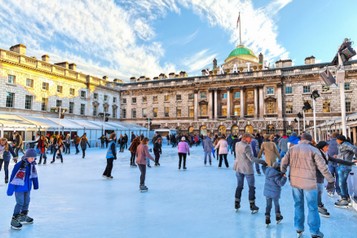 In the winter, the paved courtyard of Somerset House, surrounded by the elegant neo-classical facades of the nearby buildings, transforms to become an incredibly popular ice-skating rink. It is surrounded by the warm gazebos of cafés, where one may drink a piping-hot beverage to bolster one's energy. During the Christmas period, there is a huge Christmas tree. It is a most enjoyable experience because many of those who throw themselves onto the icy floor are not experienced skaters, thus engaging in antics such as falling over or flinging their arms forward in search of some form of support. Everyone is willing to have a laugh at their own expense, and the atmosphere is a happy one. The children often wear hefty mittens and one may happen to see men wearing a suit and tie, perhaps having just left the office. At night, the blue lighting turns it into a magical and romantic place, which makes London a place to be loved even during the winter.
In the winter, the paved courtyard of Somerset House, surrounded by the elegant neo-classical facades of the nearby buildings, transforms to become an incredibly popular ice-skating rink. It is surrounded by the warm gazebos of cafés, where one may drink a piping-hot beverage to bolster one's energy. During the Christmas period, there is a huge Christmas tree. It is a most enjoyable experience because many of those who throw themselves onto the icy floor are not experienced skaters, thus engaging in antics such as falling over or flinging their arms forward in search of some form of support. Everyone is willing to have a laugh at their own expense, and the atmosphere is a happy one. The children often wear hefty mittens and one may happen to see men wearing a suit and tie, perhaps having just left the office. At night, the blue lighting turns it into a magical and romantic place, which makes London a place to be loved even during the winter. ROMAN BATH
5, STRAND LANE
UNDERGROUND: TEMPLE
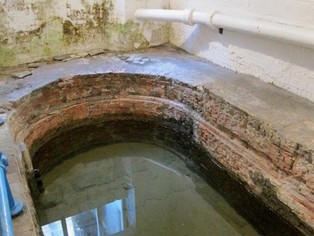 Some say that David Copperfield is the only man to have ever bathed here. Dickens does in fact describe David's dives into the cold water as being "in the Roman bath at the end of a cross street of the Strand". However, in spite of Dickens' historical endorsement of the bath, its origin remains uncertain. Its measurements are typical of the Tudor period, therefore it is likely that it dates back to the Eighteenth Century. Today it belongs to The National Trust and is rather neglected. One can switch the light on from the outside - the switch is indicated by a light bulb drawn on the wall - and one will see an old, empty bath, which is rather shabby. Within it, cold water flows from a natural source.
Some say that David Copperfield is the only man to have ever bathed here. Dickens does in fact describe David's dives into the cold water as being "in the Roman bath at the end of a cross street of the Strand". However, in spite of Dickens' historical endorsement of the bath, its origin remains uncertain. Its measurements are typical of the Tudor period, therefore it is likely that it dates back to the Eighteenth Century. Today it belongs to The National Trust and is rather neglected. One can switch the light on from the outside - the switch is indicated by a light bulb drawn on the wall - and one will see an old, empty bath, which is rather shabby. Within it, cold water flows from a natural source. THE CHURCHES OF THE WOMEN OF THE NAVY
STRAND
UNDERGROUND: TEMPLE
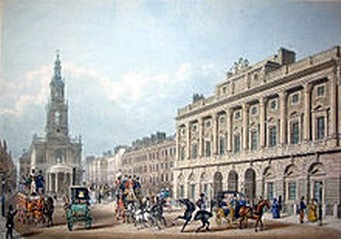 The church of St Mary-le-Strand is the official one for the Women Royal Naval Service. A book preserved within it reminds us of all the women who died in service. The building dates back to 1717, although at the eastern extremity of The Strand, there was already a church in 1150. It is nicknamed Island Church because of the fact that it stands upon a pedestrian island. In 1809, Dickens' parents were married here. The windows on the lower floor are blank, and the balustrade at the top of the building is decorated with vases. The eastern apse is inspired by the Church of the Twelve Holy Apostles and the church of Santi Luca e Martina, both in Rome. The ceiling is decorated with a pattern of alternating rhombuses and squares, in gold and white hues.
The church of St Mary-le-Strand is the official one for the Women Royal Naval Service. A book preserved within it reminds us of all the women who died in service. The building dates back to 1717, although at the eastern extremity of The Strand, there was already a church in 1150. It is nicknamed Island Church because of the fact that it stands upon a pedestrian island. In 1809, Dickens' parents were married here. The windows on the lower floor are blank, and the balustrade at the top of the building is decorated with vases. The eastern apse is inspired by the Church of the Twelve Holy Apostles and the church of Santi Luca e Martina, both in Rome. The ceiling is decorated with a pattern of alternating rhombuses and squares, in gold and white hues. At its origins, there was a maypole in front of the church, a pole adorned with flowers, where one would dance during the May Day festival. When it was torn down, due to its being old and worn, Isaac Newton asked for it, so that he could mount a telescope atop it. The loss of the maypole was even captured in a couplet by James Bramston:
"What's not destroyed by Time's devouring Hand?
Where's Troy and where's the Maypole in the Strand?"
Robert Devereux, to whom the street is dedicated, was born in 1565 and was the second count of Essex. His bust decorates the facade of the homonymous pub, located at the end of a side street behind Strand, in a small courtyard. The Building has been declared of historical interest. There is a restaurant on the ground floor, and a restaurant on the first.
DEVEREUX STREET
UNDERGROUND: WANDSWORTH COMMON
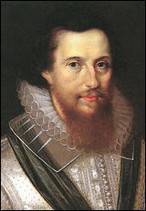 Devereux was a personable man, as well as being the favourite of Queen Elizabeth. He was part of Francis Drake's English Armada and took part in numerous campaigns against the Irish. When he was condemned to death for treason, in order to avoid being executed, he sent the Queen back a ring that she had given him as token of loyalty. Unfortunately, the delivery, a symbol of the obligation of gratitude, was intercepted, and he went on to become the last condemned man to be beheaded in the Tower of London, on Tower Green. Gaetano Donizzetti makes him speak the words "Oh reo destin crudel!" (Oh cruel destiny!), in his 1837 opera on this historical character, with the booklet by Salvadore Cammarano.
Devereux was a personable man, as well as being the favourite of Queen Elizabeth. He was part of Francis Drake's English Armada and took part in numerous campaigns against the Irish. When he was condemned to death for treason, in order to avoid being executed, he sent the Queen back a ring that she had given him as token of loyalty. Unfortunately, the delivery, a symbol of the obligation of gratitude, was intercepted, and he went on to become the last condemned man to be beheaded in the Tower of London, on Tower Green. Gaetano Donizzetti makes him speak the words "Oh reo destin crudel!" (Oh cruel destiny!), in his 1837 opera on this historical character, with the booklet by Salvadore Cammarano. The plot was based on the Elisabeth D'Angleterre by François d'Ancelot. With this opera, the composer, who had written the Anna Bolena, and the Maria Stuarda, closed the cycle of the Tudor queens.
TWININGS TEA
216, STRAND
UNDERGROUND: TEMPLE
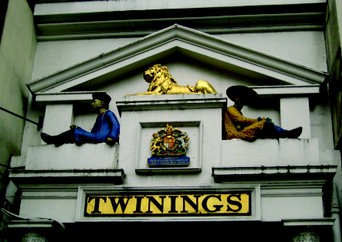 The tea room and the storehouse of the Twinings Tea and Coffee were already here, at the same address, in 1710. Thomas Twining, supplier of the Royal House, was the very first contributor to the City of Westminster. His company, as well as being the oldest to operate in that same place, has belonged to the same family for three hundred years. Considering that the period of time that separates two consecutive generations is around twenty-five years, three centuries amounts to about ten generations. The society also founded the Ethical Tea Partnership which operates in the sense of fair trade.
The tea room and the storehouse of the Twinings Tea and Coffee were already here, at the same address, in 1710. Thomas Twining, supplier of the Royal House, was the very first contributor to the City of Westminster. His company, as well as being the oldest to operate in that same place, has belonged to the same family for three hundred years. Considering that the period of time that separates two consecutive generations is around twenty-five years, three centuries amounts to about ten generations. The society also founded the Ethical Tea Partnership which operates in the sense of fair trade. On the facade of the shop there are two statuettes of Chinese men sitting with their legs out, which have been here since 1787. The one on the left has a blue tunic and a skullcap, whereas the one on the right has a yellow garment and a large straw hat. At the centre there is a lion, which serves as a reminder that the original shop used to stand just next to the sign known as the Sign of the Golden Lion. The definition was born with King Henry I, known as the "Lion of Justice", who started up a small zoo in Woodstock. The enclosure also hosted lions, animals which had never been seen before in England. The reason for the two Chinese statuettes is that, in those times, tea was imported from China. Nowadays it is imported from many other countries as well, in order to offer a wider range of choice.
On Strand, west of the Temple Bar, we also find the palace of the Royal Court of Justice. Its construction began in 1866 following the design of George Edmund Street and required about twenty years, to the point that the architect had died by the time the building was complete.
The facade overlooking the Strand is in the Gothic style of the Thirteenth Century and spans around one hundred and fifty metres in length, which on the inside corresponds with the great hall where lawyers meet with clients. On the eastern corner there is a clock tower.
ST CLEMENT DANES AND THE RAF
STRAND
UNDERGROUND: TEMPLE
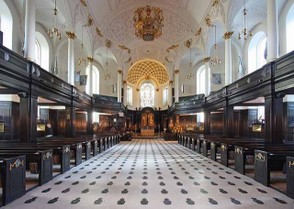 The name of St Clement Danes derives from that of a previous church, founded by Danes who were descendents of the invaders in the days of King Alfred. St Clement is considered the patron of sailors, as he suffered martyrdom tied to an anchor and was then cast into the Black Sea.
The name of St Clement Danes derives from that of a previous church, founded by Danes who were descendents of the invaders in the days of King Alfred. St Clement is considered the patron of sailors, as he suffered martyrdom tied to an anchor and was then cast into the Black Sea. The church stands on a pedestrian island in the middle of Strand. Wren rebuilt it in 1682, conserving the sixteenth-century tower. He enclosed it within new walling and added an entrance with a dome next to it. In 1941 the church was ravaged by a bomb, which uncovered a medieval crypt. Since 1958, this has been the church of the Royal Air Force. Within its vast nave, over seven hundred air team badges are exhibited.

A musical box plays the Old Hundredth, the Air Force march. An old chain is placed inside the wall, and was used for fixing the covers of coffins after burial. This way, it was possible to prevent body snatchers from stealing cadavers to sell them. In fact, during the Nineteenth Century, stealing dead bodies for doctors and scientists was a way like any other to make a living.
The church bells are mentioned in the nursery rhyme Oranges and Lemons. Each year, during the Lent service, each child who takes part is given a lemon and an orange to take home. In the presbytery there are two thrones upon which lie some cushions with sixteenth-century Italian embroidery.
MARCONI HOUSE
STRAND
UNDERGROUND: TEMPLE
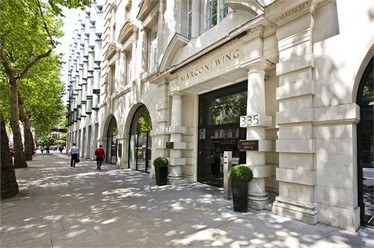 At its origin, the building hosted the Gaiety Restaurant, which was found next to the homonymous theatre. It was later purchased by the electrical energy company and transformed. The inside has been completely emptied and only the weight-bearing walls have been left standing. Today it hosts the headquarters of a bank. Above the entrance door, there is an engraving of Guglielmo Marconi's name, and just next to it a plaque which states: "From this site Guglielmo Marconi made the first public transmission of wireless signals on 27th January 1896". That year, on March 5th, Marconi had in fact followed his mother's advice, and presented the English government with a description of his device. On June 2nd, he deposited a final plan for a system of wireless telegraphy at the London Patents Office. The title of the project was: Development in the transmission of impulses and electrical signals and the relative devices. The first official experiment took place in front of the chief engineer of the Post Office, William H. Preece, and had established a connection between the Post Office and the Saving Bank in Queen Victoria Street, which was little more than a kilometre away. The bank had been fitted with a printing Morse code device.
At its origin, the building hosted the Gaiety Restaurant, which was found next to the homonymous theatre. It was later purchased by the electrical energy company and transformed. The inside has been completely emptied and only the weight-bearing walls have been left standing. Today it hosts the headquarters of a bank. Above the entrance door, there is an engraving of Guglielmo Marconi's name, and just next to it a plaque which states: "From this site Guglielmo Marconi made the first public transmission of wireless signals on 27th January 1896". That year, on March 5th, Marconi had in fact followed his mother's advice, and presented the English government with a description of his device. On June 2nd, he deposited a final plan for a system of wireless telegraphy at the London Patents Office. The title of the project was: Development in the transmission of impulses and electrical signals and the relative devices. The first official experiment took place in front of the chief engineer of the Post Office, William H. Preece, and had established a connection between the Post Office and the Saving Bank in Queen Victoria Street, which was little more than a kilometre away. The bank had been fitted with a printing Morse code device.On 12th December 1901, the first transoceanic radio signal arrived from St John's, in the Terra Nova islands. The wireless telegraph system was ready.
In Aldwych, near Marconi House, stands India House, headquarters of the Indian Commission. One comes here for visas, but also to obtain information and brochures about the country.
The building is located between the London School of Economics and King's College. It was designed in 1930 by Herbert Baker, who had already designed the Delhi Parliament House. It was opened on 8th July by George V with an impressive ceremony, whereby the king opened the door with a massive gold key. The beautiful wall art on the inside was carried out by Indian artists who had been sent to Rome and Venice before starting on the work. The commissioners insisted that they draw inspiration from Italian masterpieces. There are representations of the cycle of life and the offerings to the divinities. The vividly coloured figures painted on a gold background are quite splendid. There are also sculptures and bas-reliefs of Indian gods.
ZIMBABWE HOUSE
429, STRAND
UNDERGROUND: TEMPLE
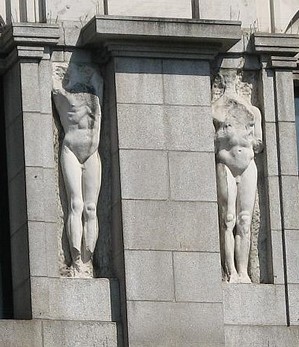 From 1923 to 1980, the house on the corner where Trafalgar Square meets Agar Street was the headquarters of the Rhodesia House. From the Independence onwards, it hosted the embassy of Zimbabwe. In 2003 the state exited the Commonwealth as a protest towards the criticism against Mugabe's regime. The building was built in 1907 for the Association of British Medics. The latter had in fact decided to commission Epstein with the decoration of the facades. The sculptor assigned Charles Holden with the drawings, and he himself sculpted eighteen nudes, both female and male, which today are in a terrible state. Epstein used a very porous stone, which absorbs water and freezes inside during the winter, causing the stone to crack and break. One day, a falling penis narrowly missed a passer-by. Thus, the authorities officially decided that all male nudes be emasculated. The figures are at the level of the second floor, next to the windows, and represent the ages of Man. On the opening day, they created a scandal, which was blown up by the newspapers. The articles on the daily papers encouraged passers-by to cover the eyes of children and fiancées when nearing the building. The directors of the biblical association, whose offices stood directly opposite, installed frosted window panes in order to avoid exposing their employees to the scandalous sight.
From 1923 to 1980, the house on the corner where Trafalgar Square meets Agar Street was the headquarters of the Rhodesia House. From the Independence onwards, it hosted the embassy of Zimbabwe. In 2003 the state exited the Commonwealth as a protest towards the criticism against Mugabe's regime. The building was built in 1907 for the Association of British Medics. The latter had in fact decided to commission Epstein with the decoration of the facades. The sculptor assigned Charles Holden with the drawings, and he himself sculpted eighteen nudes, both female and male, which today are in a terrible state. Epstein used a very porous stone, which absorbs water and freezes inside during the winter, causing the stone to crack and break. One day, a falling penis narrowly missed a passer-by. Thus, the authorities officially decided that all male nudes be emasculated. The figures are at the level of the second floor, next to the windows, and represent the ages of Man. On the opening day, they created a scandal, which was blown up by the newspapers. The articles on the daily papers encouraged passers-by to cover the eyes of children and fiancées when nearing the building. The directors of the biblical association, whose offices stood directly opposite, installed frosted window panes in order to avoid exposing their employees to the scandalous sight.THE FLYING FISH OF LLOYD'S BANK
STRAND
UNDERGROUND: TEMPLE
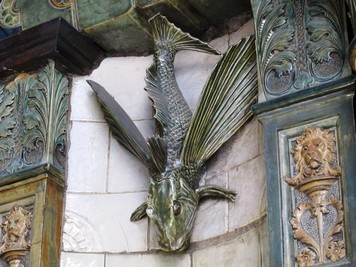 The naked bodies caused much criticism, as the public felt offended by nudity.
The naked bodies caused much criticism, as the public felt offended by nudity.However all Epstein's works had always challenged the taboos of the age. His sculptures and bas-reliefs, so vigorous and realistic, which seem as if roughly cut out with an axe, represent a rebellion against a more "gracious" art, rich with adornments. Unfortunately, no restoration work has ever been carried out on the figures on Zimbabwe House, and their survival is compromised.
The vestibule of the branch of the Lloyd's Bank Law Courts was designed and painted by J.H. McLennan in a style in-between baroque and oriental. It was conceived in 1883 for the Palgrave Hotel, which occupied the building at the time.
The portal bears some beautiful squiggles in cast iron which are quite peculiar. At the centre of the door, there is a shining golden relief of a hive, with bees flying all around it. The atrium is really quite impressive. It feels much like being within an oriental temple, with its elaborate multicolour decorations, in hues of blue, white, and brown.
There are geometric illustrations in the shapes of stars, arabesque recurring floral patterns, and small figures of animals spread on different floors. There are flying fish, lion heads, acanthus leaves, and half-naked male figures flexing their muscles in a show of strength. The ceramics have been fulfilled with a refined technique, with attention not only to the knowledgeable juxtaposition of colours, but also the alternation between shiny and opaque tiles. The pillars are built in various types of marble and the fountain has a base shaped like a goblet.
BUSH HOUSE
KINGSWAY
UNDERGROUND: TEMPLE
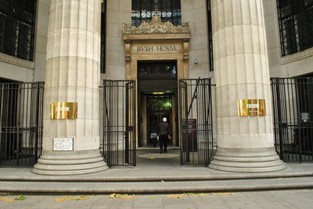 It is one of the four great palaces, arranged in a semi-circle, which stand between Aldwych and Strand, at one end of Kingsway. Aldwych is the arch-shaped street which "leans on" Strand and most likely gets its name from an ancient Dane settlement. At one time, here there were small picturesque streets flanked by run-down houses which, at the beginning of the Twentieth Century, were demolished in order to construct the buildings which now stand in their place. Amongst the latter, is Bush House. The pretty building dates back to 1919 and was designed by the American architect, Harvey Corbett. It hosts the overseas services of the BBC World Service, which broadcasts all over the world "every hour by the hour", as the famous slogan goes. Above the door there is an engraved phrase: "To the Friendship of English Speaking People" and in the lunette of the colonnade, there are two statues symbolizing England and America.
It is one of the four great palaces, arranged in a semi-circle, which stand between Aldwych and Strand, at one end of Kingsway. Aldwych is the arch-shaped street which "leans on" Strand and most likely gets its name from an ancient Dane settlement. At one time, here there were small picturesque streets flanked by run-down houses which, at the beginning of the Twentieth Century, were demolished in order to construct the buildings which now stand in their place. Amongst the latter, is Bush House. The pretty building dates back to 1919 and was designed by the American architect, Harvey Corbett. It hosts the overseas services of the BBC World Service, which broadcasts all over the world "every hour by the hour", as the famous slogan goes. Above the door there is an engraved phrase: "To the Friendship of English Speaking People" and in the lunette of the colonnade, there are two statues symbolizing England and America. The television, however, does not only broadcast in English, but in forty-two different languages. The first owner of the building, which now belongs to a Japanese company, was Irving T. Bush, and the building got its name from him. In 1930, during the excavation which took place in order to build the eastern wing, a bas-relief in Carrara marble was unearthed, and is now exhibited near the stairwell. It bears the sculpted effigy of an ancient Roman wearing a stern expression. Perhaps there was once a Roman villa here once, and if so this finding may be all that is left of it.
